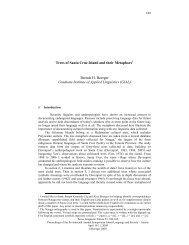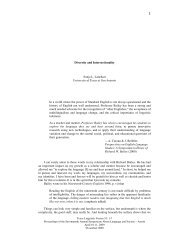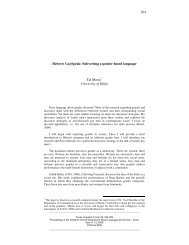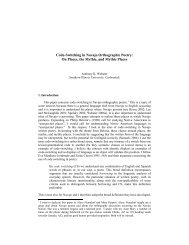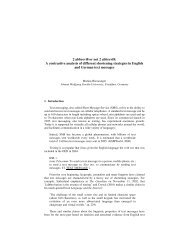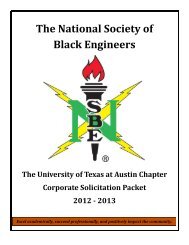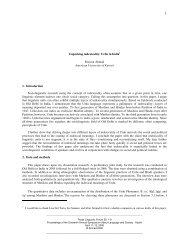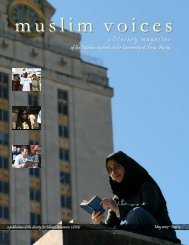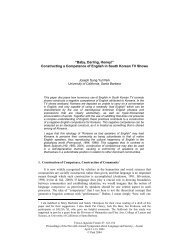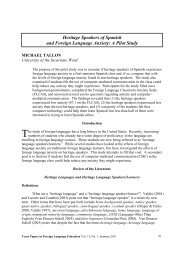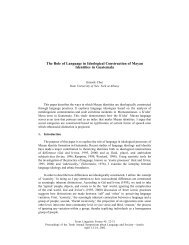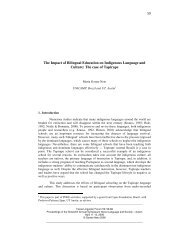The Effects of Computer-Mediated Communication on Foreign ...
The Effects of Computer-Mediated Communication on Foreign ...
The Effects of Computer-Mediated Communication on Foreign ...
You also want an ePaper? Increase the reach of your titles
YUMPU automatically turns print PDFs into web optimized ePapers that Google loves.
<str<strong>on</strong>g>The</str<strong>on</strong>g> <str<strong>on</strong>g>Effects</str<strong>on</strong>g> <str<strong>on</strong>g>of</str<strong>on</strong>g> <str<strong>on</strong>g>Computer</str<strong>on</strong>g>-<str<strong>on</strong>g>Mediated</str<strong>on</strong>g> <str<strong>on</strong>g>Communicati<strong>on</strong></str<strong>on</strong>g> <strong>on</strong> <strong>Foreign</strong><br />
Language Anxiety in Heritage and N<strong>on</strong>-Heritage Students <str<strong>on</strong>g>of</str<strong>on</strong>g><br />
Spanish: A Preliminary Investigati<strong>on</strong><br />
MICHAEL TALLON<br />
University <str<strong>on</strong>g>of</str<strong>on</strong>g> the Incarnate Word<br />
F<br />
<str<strong>on</strong>g>The</str<strong>on</strong>g> purpose <str<strong>on</strong>g>of</str<strong>on</strong>g> this study was to examine if heritage students <str<strong>on</strong>g>of</str<strong>on</strong>g> Spanish experience<br />
foreign language anxiety in a sec<strong>on</strong>d-semester Spanish class and, if so, compare that with<br />
the levels <str<strong>on</strong>g>of</str<strong>on</strong>g> foreign language anxiety found in n<strong>on</strong>-heritage students. <str<strong>on</strong>g>The</str<strong>on</strong>g> study also<br />
examined whether computer-mediated communicati<strong>on</strong> had an effect <strong>on</strong> anxiety levels,<br />
both for heritage students and n<strong>on</strong>-heritage students. A questi<strong>on</strong>naire assessing foreign<br />
language anxiety was administered as a pretest and posttest. <str<strong>on</strong>g>The</str<strong>on</strong>g>re were three groups <str<strong>on</strong>g>of</str<strong>on</strong>g><br />
students: traditi<strong>on</strong>al class/face-to-face c<strong>on</strong>versati<strong>on</strong>s (c<strong>on</strong>trol group), small groups <str<strong>on</strong>g>of</str<strong>on</strong>g><br />
asynchr<strong>on</strong>ous computer-mediated communicati<strong>on</strong> (experimental group A), and <strong>on</strong>e large<br />
group <str<strong>on</strong>g>of</str<strong>on</strong>g> asynchr<strong>on</strong>ous computer-mediated communicati<strong>on</strong> (experimental group B. <str<strong>on</strong>g>The</str<strong>on</strong>g><br />
c<strong>on</strong>trol group had regular face-to-face discussi<strong>on</strong>s in the classroom. Experimental groups<br />
A and B had electr<strong>on</strong>ic, asynchr<strong>on</strong>ous discussi<strong>on</strong>s using BlackBoard. <str<strong>on</strong>g>The</str<strong>on</strong>g> findings show<br />
that heritage students <str<strong>on</strong>g>of</str<strong>on</strong>g> Spanish experienced less foreign language anxiety than n<strong>on</strong>heritage<br />
students. Furthermore, the use <str<strong>on</strong>g>of</str<strong>on</strong>g> computer-mediated communicati<strong>on</strong> can reduce<br />
learners‟ anxiety levels. <str<strong>on</strong>g>The</str<strong>on</strong>g> size <str<strong>on</strong>g>of</str<strong>on</strong>g> the asynchr<strong>on</strong>ous computer-mediated<br />
communicati<strong>on</strong> group did not seem to affect the overall anxiety scores, although the large<br />
group did cause heritage students to experience higher levels <str<strong>on</strong>g>of</str<strong>on</strong>g> anxiety than n<strong>on</strong>-heritage<br />
students.<br />
oreign language teachers have l<strong>on</strong>g sought new and better ways to help their students<br />
learn the foreign/sec<strong>on</strong>d language. One area that has provided much excitement is the use <str<strong>on</strong>g>of</str<strong>on</strong>g><br />
computers and, specifically, computer-mediated communicati<strong>on</strong> (CMC). Research has shown<br />
that CMC can provide many benefits to the sec<strong>on</strong>d language learner. One area that has not been<br />
investigated much yet is the ability <str<strong>on</strong>g>of</str<strong>on</strong>g> CMC to reduce anxiety, although there are a few studies<br />
available (see Arnold, 2002; Kern, 1995; Warschauer, 1996; Sullivan & Pratt, 1996; Beauvois,<br />
1995, 1999).<br />
<str<strong>on</strong>g>The</str<strong>on</strong>g> purpose <str<strong>on</strong>g>of</str<strong>on</strong>g> this study is tw<str<strong>on</strong>g>of</str<strong>on</strong>g>old: to determine if heritage students <str<strong>on</strong>g>of</str<strong>on</strong>g> Spanish<br />
experience foreign language anxiety, and to determine the effects <str<strong>on</strong>g>of</str<strong>on</strong>g> asynchr<strong>on</strong>ous computermediated<br />
communicati<strong>on</strong> (ACMC) <strong>on</strong> the anxiety levels <str<strong>on</strong>g>of</str<strong>on</strong>g> heritage and n<strong>on</strong>-heritage students <str<strong>on</strong>g>of</str<strong>on</strong>g><br />
Spanish. This study is significant because <str<strong>on</strong>g>of</str<strong>on</strong>g> the increasing number <str<strong>on</strong>g>of</str<strong>on</strong>g> heritage students<br />
enrolling in first-year Spanish courses. Because they are different from the traditi<strong>on</strong>al foreign<br />
language student – and thus have different needs – it is important to investigate how teachers can<br />
attend to their affective needs as well. <str<strong>on</strong>g>The</str<strong>on</strong>g> Review <str<strong>on</strong>g>of</str<strong>on</strong>g> the Literature secti<strong>on</strong> will discuss<br />
computer-mediated communicati<strong>on</strong>, asynchr<strong>on</strong>ous computer-mediated communicati<strong>on</strong>, foreign<br />
language anxiety and computer-mediated communicati<strong>on</strong>, and definiti<strong>on</strong>s <str<strong>on</strong>g>of</str<strong>on</strong>g> heritage students <str<strong>on</strong>g>of</str<strong>on</strong>g><br />
TPFLE Vol.13, No.1, Fall/Winter 2009 39
Spanish. This will be followed by a descripti<strong>on</strong> <str<strong>on</strong>g>of</str<strong>on</strong>g> the research methodology and a presentati<strong>on</strong><br />
<str<strong>on</strong>g>of</str<strong>on</strong>g> the results and their implicati<strong>on</strong>s.<br />
REVIEW OF THE LITERATURE<br />
<str<strong>on</strong>g>Computer</str<strong>on</strong>g>-<str<strong>on</strong>g>Mediated</str<strong>on</strong>g> <str<strong>on</strong>g>Communicati<strong>on</strong></str<strong>on</strong>g><br />
<str<strong>on</strong>g>Computer</str<strong>on</strong>g>-mediated communicati<strong>on</strong> has been heralded as providing several potential<br />
benefits to the foreign language classroom. It has been suggested that CMC encourages learners<br />
to engage in meaningful interacti<strong>on</strong>s and authentic exchanges in the target language (Chun,<br />
1994; Warschauer, 1996; Warschauer & Meskill, 2000; Blake, 2000; van Lier, 2000; Stockwell<br />
& Harringt<strong>on</strong>, 2003; Pica, 1987; Ellis, 1999). Warschauer (1997) c<strong>on</strong>cludes that “the textmediati<strong>on</strong>al<br />
view links the c<strong>on</strong>cepts <str<strong>on</strong>g>of</str<strong>on</strong>g> expressi<strong>on</strong>, interacti<strong>on</strong>, reflecti<strong>on</strong>, problem-solving,<br />
critical thinking, and literacy with the various uses <str<strong>on</strong>g>of</str<strong>on</strong>g> talk, text, inquiry and collaborati<strong>on</strong> in the<br />
classroom” (p. 472). Blake (2000) adds: “Providing students with increased opportunities to<br />
engage in negotiati<strong>on</strong>s…could direct language teachers to accord CMC a more expanded role in<br />
the L2 curriculum” (p. 132).<br />
A sec<strong>on</strong>d benefit <str<strong>on</strong>g>of</str<strong>on</strong>g> CMC is more equal participati<strong>on</strong> by students. Warschauer (1996)<br />
compared face-to-face discussi<strong>on</strong>s and electr<strong>on</strong>ic discussi<strong>on</strong>s and found a tendency toward more<br />
equal participati<strong>on</strong> in the computer mode, with “the overall participati<strong>on</strong> rate twice as equal in<br />
electr<strong>on</strong>ic discussi<strong>on</strong> as in face-to-face discussi<strong>on</strong>” (p. 20). Bump (1990), Beauvois (1998,<br />
1999), Kelm (1992) and Kim (1998) also report more student participati<strong>on</strong> using CMC. Sullivan<br />
& Pratt (1996) report a 100% participati<strong>on</strong> rate for a CMC class versus 50% for an oral class.<br />
Warschauer (1997), in his review <str<strong>on</strong>g>of</str<strong>on</strong>g> the CMC literature, states that a greater amount <str<strong>on</strong>g>of</str<strong>on</strong>g> student<br />
participati<strong>on</strong> using CMC has been found according to three measures: (1) percentage <str<strong>on</strong>g>of</str<strong>on</strong>g> student<br />
talk versus teacher talk, (2) directi<strong>on</strong>al focus <str<strong>on</strong>g>of</str<strong>on</strong>g> student talk (toward other students or toward the<br />
teacher), and (3) equality <str<strong>on</strong>g>of</str<strong>on</strong>g> student participati<strong>on</strong>. Warschauer, Turbee, & Roberts (1996)<br />
c<strong>on</strong>cluded that computer learning networks have the potential to empower students by promoting<br />
student aut<strong>on</strong>omy, increasing classroom equality, and helping students develop a critical learning<br />
perspective.<br />
Some studies have shown that students who <str<strong>on</strong>g>of</str<strong>on</strong>g>ten feel marginalized, or students who<br />
might be shier, in traditi<strong>on</strong>al classroom discussi<strong>on</strong>s become more active in a networked<br />
classroom. Sullivan (1998) illustrated how computer exchanges can promote the self-esteem <str<strong>on</strong>g>of</str<strong>on</strong>g><br />
minority students and build a discourse community within their compositi<strong>on</strong> class. Sullivan<br />
found more participati<strong>on</strong> by minorities and c<strong>on</strong>cluded that they were able to define themselves<br />
by their communicative skills. Warschauer (1996) also reported increased participati<strong>on</strong> via<br />
CMC for certain nati<strong>on</strong>ality groups (Chinese, Japanese, and Vietnamese). Markley (1998)<br />
reports that cultural backgrounds have an effect <strong>on</strong> participati<strong>on</strong> in the classroom and that CMC<br />
can help equalize the participati<strong>on</strong>; in his study, Asians and women participated more via CMC<br />
than in the traditi<strong>on</strong>al classroom.<br />
Another benefit is the use <str<strong>on</strong>g>of</str<strong>on</strong>g> more sophisticated language in CMC. Chun (1994) found<br />
that learners who participated in computer-assisted classroom discussi<strong>on</strong>s (CACD) performed a<br />
number <str<strong>on</strong>g>of</str<strong>on</strong>g> different interacti<strong>on</strong>al speech acts (including initiating and resp<strong>on</strong>ding to simple<br />
statements, asking and answering questi<strong>on</strong>s, and using greetings/farewells) and took the initiative<br />
more than they did in the normal classroom. Chun suggests that the written competence gained<br />
from CACD can gradually be transferred to the students‟ spoken discourse competence. Other<br />
2 40<br />
TPFLE
studies have also found a greater level <str<strong>on</strong>g>of</str<strong>on</strong>g> sophisticati<strong>on</strong> am<strong>on</strong>g students who used networked<br />
computers for class discussi<strong>on</strong>s (Kern 1995, Beauvois 1998). Warschauer (1996) c<strong>on</strong>cludes that<br />
the results <str<strong>on</strong>g>of</str<strong>on</strong>g> his study “suggest that electr<strong>on</strong>ic discussi<strong>on</strong> can be a good envir<strong>on</strong>ment for<br />
fostering use <str<strong>on</strong>g>of</str<strong>on</strong>g> more formal and complex language, both lexically and syntactically” (p.22).<br />
Beauvois (1998) c<strong>on</strong>cludes that electr<strong>on</strong>ic discussi<strong>on</strong>s show favorable results in the areas <str<strong>on</strong>g>of</str<strong>on</strong>g><br />
quantity, quality, and greater student participati<strong>on</strong> and, therefore, that “the slowing down <str<strong>on</strong>g>of</str<strong>on</strong>g> the<br />
communicative process seems to bridge the gap between oral and written communicati<strong>on</strong> for a<br />
number <str<strong>on</strong>g>of</str<strong>on</strong>g> students, allowing them to benefit more fully from the language learning process”<br />
(213).<br />
Asynchr<strong>on</strong>ous computer-mediate communicati<strong>on</strong> (ACMC) refers to communicati<strong>on</strong> that<br />
does not take place in real time (as opposed to synchr<strong>on</strong>ous computer-mediated communicati<strong>on</strong> -<br />
SCMC). Examples <str<strong>on</strong>g>of</str<strong>on</strong>g> ACMC include e-mail and posting messages to an electr<strong>on</strong>ic discussi<strong>on</strong><br />
board. Stockwell & Harringt<strong>on</strong> (2003) note several advantages <str<strong>on</strong>g>of</str<strong>on</strong>g> e-mail interacti<strong>on</strong>: (1)<br />
learners have more time to focus <strong>on</strong> the linguistic cues; (2) learners have more time to<br />
comprehend and then resp<strong>on</strong>d; and (3) learners may feel less anxiety than is comm<strong>on</strong> in face-t<str<strong>on</strong>g>of</str<strong>on</strong>g>ace<br />
settings “where c<strong>on</strong>siderati<strong>on</strong>s <str<strong>on</strong>g>of</str<strong>on</strong>g> saving face can heighten learner anxiety” (p. 351).<br />
Kro<strong>on</strong>enberg (1994/1995) states that e-mail “encourages students to use computers in realistic<br />
situati<strong>on</strong>s so that they can develop communicative and thinking skills. Even the technologically<br />
phobic language teacher can become adept at engaging students to use e-mail in skill<br />
development” (p. 24).<br />
Some researchers have found that the size <str<strong>on</strong>g>of</str<strong>on</strong>g> the group can have an effect <strong>on</strong> CMC,<br />
possibly leading to anxiety. For example, Beauvois (1995) found that students expressed<br />
frustrati<strong>on</strong> at trying to keep up with discussi<strong>on</strong> with a large number <str<strong>on</strong>g>of</str<strong>on</strong>g> students and preferred to<br />
form their own small discussi<strong>on</strong> groups <strong>on</strong> the network. Other researchers (e.g., Bump, 1990;<br />
Colomb & Simutis, 1996; Kelm, 1992) noted that <strong>on</strong>e disadvantage <str<strong>on</strong>g>of</str<strong>on</strong>g> CMC is that with large<br />
groups the c<strong>on</strong>versati<strong>on</strong> can produce a large body <str<strong>on</strong>g>of</str<strong>on</strong>g> text, thus making it difficult to keep up with<br />
the c<strong>on</strong>versati<strong>on</strong>. Warschauer (1997) refers to this as “informati<strong>on</strong> overload,” as participants<br />
become overwhelmed with the number <str<strong>on</strong>g>of</str<strong>on</strong>g> messages. One student in Bump‟s (1990) study stated<br />
that “it gets frustrating sometimes when a [chat room c<strong>on</strong>versati<strong>on</strong>] gets really busy and you<br />
would have no time to type anything in if you worried about reading absolutely everything” (p.<br />
61). To overcome such problems, Beauvois (1992) recommends having many small<br />
c<strong>on</strong>versati<strong>on</strong>s and Bump (1990) recommends limiting the size <str<strong>on</strong>g>of</str<strong>on</strong>g> each group to no more than<br />
four or five people.<br />
<strong>Foreign</strong> Language Anxiety<br />
Several researchers have suggested that the use <str<strong>on</strong>g>of</str<strong>on</strong>g> CMC has the potential to reduce<br />
anxiety associated with learning a foreign/sec<strong>on</strong>d language. Anxiety can be defined as “the<br />
subjective feeling <str<strong>on</strong>g>of</str<strong>on</strong>g> tensi<strong>on</strong>, apprehensi<strong>on</strong>, nervousness, and worry associated with an arousal <str<strong>on</strong>g>of</str<strong>on</strong>g><br />
the aut<strong>on</strong>omic nervous system” (Horwitz, Horwitz & Cope, 1986, p. 125; from Spielberger<br />
1983). “<strong>Foreign</strong> Language Anxiety,” first proposed by Horwitz, Horwitz & Cope (1986), can be<br />
defined as “a distinct complex <str<strong>on</strong>g>of</str<strong>on</strong>g> self-percepti<strong>on</strong>s, beliefs, feelings, and behaviors related to<br />
classroom language learning arising from the uniqueness <str<strong>on</strong>g>of</str<strong>on</strong>g> the language learning process” (p.<br />
128) and is made up <str<strong>on</strong>g>of</str<strong>on</strong>g> communicati<strong>on</strong> apprehensi<strong>on</strong>, test anxiety, and fear <str<strong>on</strong>g>of</str<strong>on</strong>g> negative<br />
evaluati<strong>on</strong> (Horwitz, Horwitz & Cope, 1986).<br />
Most researchers accept the idea that foreign language anxiety is a situati<strong>on</strong>-specific<br />
anxiety related to the language learning c<strong>on</strong>text and that it can play a significant causal role in<br />
FOREIGN LANGUAGE ANXIETY AND CMC 41
creating individual differences in language learning. Horwitz (2001) notes that several studies<br />
have found foreign language anxiety to be largely independent <str<strong>on</strong>g>of</str<strong>on</strong>g> other types <str<strong>on</strong>g>of</str<strong>on</strong>g> anxiety.<br />
Some researchers believe that CMC can create an envir<strong>on</strong>ment in which foreign language<br />
anxiety is reduced. Kro<strong>on</strong>enberg (1994/1995) states that “the most timid language students can<br />
come alive while creating meaningful communicati<strong>on</strong> via the keyboard and screen” (p. 24).<br />
Kern (1995) reported that most students enjoyed CMC, with some evidence <str<strong>on</strong>g>of</str<strong>on</strong>g> reduced anxiety.<br />
Warschauer (1996) states that students reported “that they did not feel stress during electr<strong>on</strong>ic<br />
discussi<strong>on</strong>” (p. 16). Sullivan & Pratt (1996) state: “Hypothetically, the networked classroom<br />
would <str<strong>on</strong>g>of</str<strong>on</strong>g>fer the less pr<str<strong>on</strong>g>of</str<strong>on</strong>g>icient speaker more time to think about what to „say,‟ thus reducing<br />
anxiety and the probability <str<strong>on</strong>g>of</str<strong>on</strong>g> error” (p. 492).<br />
In a descriptive study <strong>on</strong> students‟ attitudes and motivati<strong>on</strong> <strong>on</strong> E-talk, Beauvois (1995)<br />
reports that over 70% <str<strong>on</strong>g>of</str<strong>on</strong>g> the students felt that the computer lab was much less anxiety-provoking<br />
than the regular classroom and 73% indicated that they would like to spend more time working<br />
in the lab. Based <strong>on</strong> 76 student interviews from all levels <str<strong>on</strong>g>of</str<strong>on</strong>g> classes over a three-year period,<br />
Beauvois (1999) reports that student resp<strong>on</strong>ses to CMC were unanimously positive <strong>on</strong> the<br />
questi<strong>on</strong> <str<strong>on</strong>g>of</str<strong>on</strong>g> stress/anxiety; students also commented <strong>on</strong> the social aspects <str<strong>on</strong>g>of</str<strong>on</strong>g> CMC and how it<br />
creates a sense <str<strong>on</strong>g>of</str<strong>on</strong>g> community and a socially supported envir<strong>on</strong>ment. Beauvois c<strong>on</strong>cludes:<br />
“What we do know now is that…we can use networked computers in our classrooms without<br />
activating anxiety in our students and without inhibiting their participati<strong>on</strong>” (p. 162).<br />
G<strong>on</strong>zález-Bueno & Pérez (2001) explored the significance <str<strong>on</strong>g>of</str<strong>on</strong>g> the overall effect <str<strong>on</strong>g>of</str<strong>on</strong>g> using<br />
e-mail in the quantity and accuracy <str<strong>on</strong>g>of</str<strong>on</strong>g> Spanish written language generated by the electr<strong>on</strong>ic<br />
media through dialogue journals compared to the paper-and-pencil versi<strong>on</strong> <str<strong>on</strong>g>of</str<strong>on</strong>g> the technique.<br />
Qualitative analysis revealed that a majority (86%) <str<strong>on</strong>g>of</str<strong>on</strong>g> the experimental students believed the<br />
assignment had improved their attitude towards the language, and half <str<strong>on</strong>g>of</str<strong>on</strong>g> them felt that the email<br />
journal had some advantages over its paper-and-pencil counterpart (including learning to<br />
communicate, self-m<strong>on</strong>itoring, using technology appropriately, finding the assignment fun); <strong>on</strong><br />
the other hand, <strong>on</strong>ly <strong>on</strong>e third <str<strong>on</strong>g>of</str<strong>on</strong>g> the c<strong>on</strong>trol subjects claimed that this practice was<br />
communicative, creative, meaningful and <strong>on</strong>e that produced low anxiety.<br />
Arnold (2002) investigated the relati<strong>on</strong>ship between CMC and foreign language anxiety<br />
in five secti<strong>on</strong>s <str<strong>on</strong>g>of</str<strong>on</strong>g> third-semester German classes (N=56) with SCMC, ACMC, and a traditi<strong>on</strong>al<br />
face-to-face class. She found that students‟ self-ratings <str<strong>on</strong>g>of</str<strong>on</strong>g> their anxiety and self-c<strong>on</strong>fidence<br />
levels during each discussi<strong>on</strong> did not change significantly between the three treatment groups<br />
(although 29% <str<strong>on</strong>g>of</str<strong>on</strong>g> the students experienced moderate levels <str<strong>on</strong>g>of</str<strong>on</strong>g> anxiety and 19% experienced high<br />
levels <str<strong>on</strong>g>of</str<strong>on</strong>g> anxiety); all groups generally enjoyed the group discussi<strong>on</strong>s, although the e-mail group<br />
(ACMC) provided some negative feedback (due to the lag time); in all three treatment groups,<br />
students displayed significantly lower levels <str<strong>on</strong>g>of</str<strong>on</strong>g> anxiety after the study (although modality did not<br />
have any effect <strong>on</strong> these changes). Arnold suggests using e-mail exchanges for writing practice<br />
instead <str<strong>on</strong>g>of</str<strong>on</strong>g> electr<strong>on</strong>ic discussi<strong>on</strong>s.<br />
In a later study, Arnold (2007) investigated the relati<strong>on</strong>ship between CMC and<br />
communicati<strong>on</strong> apprehensi<strong>on</strong> (<strong>on</strong>e aspect <str<strong>on</strong>g>of</str<strong>on</strong>g> the foreign language anxiety c<strong>on</strong>struct proposed by<br />
Horwitz, Horwitz & Cope, 1986). Data from pretest and posttest questi<strong>on</strong>naires showed no<br />
significant differences in a reducti<strong>on</strong> <str<strong>on</strong>g>of</str<strong>on</strong>g> communicati<strong>on</strong> apprehensi<strong>on</strong> between the c<strong>on</strong>trol and<br />
experimental groups.<br />
Perez (2003) found that students who used ACMC (e-mail in this study) “had more time<br />
to think and elaborate while writing their weekly email message; c<strong>on</strong>sequently, average students<br />
2 42<br />
TPFLE
felt more relaxed during this activity” (p. 94). She c<strong>on</strong>cluded that both modes <str<strong>on</strong>g>of</str<strong>on</strong>g> CMC (i.e.,<br />
ACMC and SCMC) created a n<strong>on</strong>threatening atmosphere and lowered the affective filter.<br />
<str<strong>on</strong>g>The</str<strong>on</strong>g> Spanish students in Lee‟s (2004) study <str<strong>on</strong>g>of</str<strong>on</strong>g> <strong>on</strong>line discussi<strong>on</strong>s experienced anxiety<br />
when communicating with native speakers at the beginning <str<strong>on</strong>g>of</str<strong>on</strong>g> the semester, as they felt that their<br />
limited Spanish did not allow them to fully express their ideas. <str<strong>on</strong>g>The</str<strong>on</strong>g>y were also afraid to make<br />
mistakes.<br />
Heritage Students <str<strong>on</strong>g>of</str<strong>on</strong>g> Spanish<br />
A heritage student refers to “a language student who is raised in a home where a n<strong>on</strong>-<br />
English language is spoken, who speaks or at least understands the language, and who is to some<br />
degree bilingual in that language and in English” (Valdés 2001). <str<strong>on</strong>g>The</str<strong>on</strong>g>re are several reas<strong>on</strong>s to<br />
focus <strong>on</strong> heritage students, especially heritage students <str<strong>on</strong>g>of</str<strong>on</strong>g> Spanish. According to Campbell &<br />
Peyt<strong>on</strong> (1997), “Interest in this student populati<strong>on</strong> has been triggered by major demographic<br />
changes in this country…Most heritage language speakers (43 percent) are Hispanic<br />
Americans…This group is now the fastest growing and most diverse populati<strong>on</strong> group in the<br />
United States” (p. 38). C<strong>on</strong>sequently, their enrollments in universities are picking up all over the<br />
country. Fishman (1966) argues that heritage languages are a nati<strong>on</strong>al resource that should be<br />
preserved and encouraged. Van Deusen-Scholl (2003) states: “<str<strong>on</strong>g>The</str<strong>on</strong>g> events <str<strong>on</strong>g>of</str<strong>on</strong>g> September 11,<br />
2001, underscored the critical need for language competence in strategic languages…Given the<br />
nati<strong>on</strong>‟s expressed need for strategic linguistic competence, rethinking the role that heritage<br />
learners can play is advisable” (p. 215).<br />
Draper & Hicks (2000) note that “heritage language learners are different from the<br />
traditi<strong>on</strong>al foreign language student” (p. 20), and, therefore, “the instructi<strong>on</strong>al goals <str<strong>on</strong>g>of</str<strong>on</strong>g> the<br />
heritage learner may clash with those <str<strong>on</strong>g>of</str<strong>on</strong>g> the program in which they seek instructi<strong>on</strong>” (Van<br />
Deusen-Scholl, 2003, p. 223). This has led researchers to try to develop a theoretical foundati<strong>on</strong><br />
for heritage language instructi<strong>on</strong> (Valdés, 2001).<br />
Webb and Miller (2000) point out that heritage language students are pr<str<strong>on</strong>g>of</str<strong>on</strong>g>icient in their<br />
language in ways that foreign language learners, and sometimes even their foreign language<br />
teachers, are not and may never be. At the same time, they may have gaps in their knowledge <str<strong>on</strong>g>of</str<strong>on</strong>g><br />
their heritage languages that foreign language learners do not have, and these gaps prevent them<br />
from performing certain kinds <str<strong>on</strong>g>of</str<strong>on</strong>g> communicative tasks, reading and writing in particular. As a<br />
result, when teachers attempt to apply a standard foreign language curriculum and foreign<br />
language teaching strategies to the teaching <str<strong>on</strong>g>of</str<strong>on</strong>g> a heritage language, it can lead to discomfort, if<br />
not frustrati<strong>on</strong> and failure, for both students and teachers alike. <strong>Foreign</strong> language learners and<br />
heritage language learners are two different groups <str<strong>on</strong>g>of</str<strong>on</strong>g> students, each with their own needs.<br />
Campbell and Rosenthal (2000) provide several characteristics <str<strong>on</strong>g>of</str<strong>on</strong>g> a “typical” heritage<br />
language learner: (1) they have acquired nearly 90% <str<strong>on</strong>g>of</str<strong>on</strong>g> the ph<strong>on</strong>ological system <str<strong>on</strong>g>of</str<strong>on</strong>g> their<br />
ancestral language; (2) they have acquired 80% to 90% <str<strong>on</strong>g>of</str<strong>on</strong>g> the grammatical rules; (3) they have<br />
acquired extensive vocabularies, although the semantic range is limited to a few sociocultural<br />
domains; (4) they have typically acquired appropriate sociolinguistic rules; (5) they have learned<br />
and adopted many <str<strong>on</strong>g>of</str<strong>on</strong>g> the customs, values, and traditi<strong>on</strong>s (i.e., the culture) <str<strong>on</strong>g>of</str<strong>on</strong>g> their community; (6)<br />
they rarely have opportunities to gain literacy skills in their ancestral languages; and (7) they<br />
present a wide range <str<strong>on</strong>g>of</str<strong>on</strong>g> reas<strong>on</strong>s for wanting to study their ancestral languages. It should be noted<br />
that their proposed hypotheses need to be validated by empirical evidence collected from both<br />
heritage students and n<strong>on</strong>-heritage students in future research.<br />
Peyt<strong>on</strong>, Ranard and McGinnis (2001) make the point that heritage language learners also<br />
differ from traditi<strong>on</strong>al foreign language learners in that many heritage language learners are<br />
FOREIGN LANGUAGE ANXIETY AND CMC 43
dealing with deeply felt issues <str<strong>on</strong>g>of</str<strong>on</strong>g> identity. Krashen (2000) adds: “Heritage language [HL]<br />
speakers are in a no-win situati<strong>on</strong> in foreign language classes. If they do well, it is expected. If<br />
HL speakers do not do well in foreign language classes, the experience is especially painful” (p.<br />
441). This can result in a lack <str<strong>on</strong>g>of</str<strong>on</strong>g> motivati<strong>on</strong>, low academic achievement, high absenteeism, and<br />
a high percentage <str<strong>on</strong>g>of</str<strong>on</strong>g> dropouts.<br />
Roca (2000) points out that many heritage students use Spanish at home and with peers,<br />
but lack formal training in the language and have a limited bilingual range. As a result, their<br />
literacy skills in Spanish (most obviously, their n<strong>on</strong>-standard spelling), their registers,<br />
vocabulary, and general ease and fluency with the language, need attenti<strong>on</strong> and expansi<strong>on</strong>.<br />
Gutiérrez (1997) states: “<str<strong>on</strong>g>The</str<strong>on</strong>g> foreign language teaching pr<str<strong>on</strong>g>of</str<strong>on</strong>g>essi<strong>on</strong> should clearly understand<br />
that these students need an approach that builds <strong>on</strong> what they bring to the classroom rather than<br />
<strong>on</strong>e that begins at ground zero” (p. 34).<br />
Heritage Students and <strong>Foreign</strong> Language Anxiety<br />
Although many studies have been c<strong>on</strong>ducted <strong>on</strong> the effects <str<strong>on</strong>g>of</str<strong>on</strong>g> foreign language anxiety<br />
<strong>on</strong> sec<strong>on</strong>d language learners, most <str<strong>on</strong>g>of</str<strong>on</strong>g> this research has been d<strong>on</strong>e with the more “traditi<strong>on</strong>al”<br />
foreign language learners. To date little research has been c<strong>on</strong>ducted <strong>on</strong> its effects <strong>on</strong> heritage<br />
students. However, there is some anecdotal evidence. For example, Levine (2003) looked at<br />
student and instructor beliefs and attitudes about target language use, first language use, and<br />
anxiety. He states that the findings in his study suggest that “students who come from bi- or<br />
multilingual backgrounds may tend to feel less anxious about TL [target language] use than<br />
students from m<strong>on</strong>olingual backgrounds” (p. 354). Mejías, Applbaum, Applbaum and Trotter<br />
(1991) found that some <str<strong>on</strong>g>of</str<strong>on</strong>g> the Hispanic students in their study experienced anxiety when<br />
speaking Spanish, especially in more formal, less pers<strong>on</strong>al c<strong>on</strong>texts.<br />
Tall<strong>on</strong> (2003) found that the mean anxiety score <strong>on</strong> the <strong>Foreign</strong> Language Classroom<br />
Anxiety Scale (FLCAS) (Horwitz, Horwitz and Cope, 1986) was significantly higher for n<strong>on</strong>heritage<br />
students (cf. 104.6) than for heritage students (cf. 87.1) in first-semester Spanish classes.<br />
It was noted in that study that the anxiety score for the heritage students was somewhat high<br />
(c<strong>on</strong>sidering that no anxiety is represented by a score <str<strong>on</strong>g>of</str<strong>on</strong>g> thirty three). In a later study, Tall<strong>on</strong><br />
(2004) found that the mean anxiety score <strong>on</strong> the FLCAS for heritage students in a sec<strong>on</strong>dsemester<br />
Spanish class was 97.0, c<strong>on</strong>sidered “mildly anxious.” In additi<strong>on</strong>, this study showed<br />
that heritage students <str<strong>on</strong>g>of</str<strong>on</strong>g> Spanish can also experience other types <str<strong>on</strong>g>of</str<strong>on</strong>g> anxiety, including listening<br />
anxiety, reading anxiety, and writing anxiety. Finally, it was suggested that the anxiety could<br />
lead to less language output, both orally and in writing, and both in terms <str<strong>on</strong>g>of</str<strong>on</strong>g> quantity <str<strong>on</strong>g>of</str<strong>on</strong>g> language<br />
and quality in language, for the heritage students.<br />
In a qualitative study <str<strong>on</strong>g>of</str<strong>on</strong>g> self-assessed anxious heritage and n<strong>on</strong>-heritage learners, Coryell<br />
& Clark (2009) examined how and why some adult learners experienced anxiety while studying<br />
Spanish <strong>on</strong>line. <str<strong>on</strong>g>The</str<strong>on</strong>g>ir participants experienced anxiety because their previous language learning<br />
experiences enforced the c<strong>on</strong>cept <str<strong>on</strong>g>of</str<strong>on</strong>g> language as performance, with a focus <strong>on</strong> grammatical<br />
correctness and precisi<strong>on</strong>. <str<strong>on</strong>g>The</str<strong>on</strong>g>y c<strong>on</strong>cluded that “the findings <str<strong>on</strong>g>of</str<strong>on</strong>g> this study suggest that<br />
traditi<strong>on</strong>al instructi<strong>on</strong>al practices <strong>on</strong>line and a lack <str<strong>on</strong>g>of</str<strong>on</strong>g> social language interacti<strong>on</strong> will likely<br />
underserve anxious, interculturally minded learners” (p. 499), advocating instead for pers<strong>on</strong>al<br />
and sociocultural c<strong>on</strong>necti<strong>on</strong>s and intercultural communicati<strong>on</strong>s as the focus <str<strong>on</strong>g>of</str<strong>on</strong>g> <strong>on</strong>line language<br />
courses.<br />
2 44<br />
TPFLE
RESEARCH QUESTIONS<br />
<str<strong>on</strong>g>The</str<strong>on</strong>g> purpose <str<strong>on</strong>g>of</str<strong>on</strong>g> this study is to determine if “foreign language anxiety” (Horwitz, Horwitz<br />
& Cope 1986) exists for heritage students <str<strong>on</strong>g>of</str<strong>on</strong>g> Spanish, and, if so, compare that with the levels <str<strong>on</strong>g>of</str<strong>on</strong>g><br />
foreign language anxiety found in n<strong>on</strong>-heritage students. <str<strong>on</strong>g>The</str<strong>on</strong>g> study will also examine if CMC –<br />
specifically, asynchr<strong>on</strong>ous CMC – has an effect <strong>on</strong> foreign language anxiety. <str<strong>on</strong>g>The</str<strong>on</strong>g> following<br />
research questi<strong>on</strong>s will be addressed:<br />
1. Do heritage students <str<strong>on</strong>g>of</str<strong>on</strong>g> Spanish experience foreign language anxiety in a<br />
sec<strong>on</strong>d-semester language classroom? If so, how does their level <str<strong>on</strong>g>of</str<strong>on</strong>g> foreign<br />
language anxiety compare to the level <str<strong>on</strong>g>of</str<strong>on</strong>g> foreign language anxiety found in<br />
n<strong>on</strong>-heritage students?<br />
2. Do students (both heritage students and n<strong>on</strong>-heritage students) experience a<br />
reducti<strong>on</strong> in foreign language anxiety by using asynchr<strong>on</strong>ous CMC (ACMC)?<br />
3. If so, does the size <str<strong>on</strong>g>of</str<strong>on</strong>g> the ACMC group (i.e., small or large) have an effect <strong>on</strong><br />
the level <str<strong>on</strong>g>of</str<strong>on</strong>g> anxiety?<br />
METHODOLOGY<br />
Participants<br />
Participants came from two secti<strong>on</strong>s <str<strong>on</strong>g>of</str<strong>on</strong>g> sec<strong>on</strong>d-semester Spanish (Elementary Spanish II)<br />
at a private American university in the southwest. Both classes were taught by the same teacher,<br />
who had been teaching Spanish for approximately ten years. One class had 22 students and the<br />
sec<strong>on</strong>d class had 9 students. Because <str<strong>on</strong>g>of</str<strong>on</strong>g> absences, the final numbers were 19 students in the first<br />
class and 7 students in the sec<strong>on</strong>d class (N=26). All subjects were 18 years or older (13 males<br />
and 13 females; average age = 22.5 years). Based <strong>on</strong> self-assessments, 15 students identified<br />
themselves as heritage students and 11 identified themselves as n<strong>on</strong>-heritage students.<br />
Procedure<br />
<str<strong>on</strong>g>The</str<strong>on</strong>g>re were three groups <str<strong>on</strong>g>of</str<strong>on</strong>g> subjects: traditi<strong>on</strong>al class/face-to-face c<strong>on</strong>versati<strong>on</strong>s (c<strong>on</strong>trol<br />
group; n=7), small groups <str<strong>on</strong>g>of</str<strong>on</strong>g> ACMC (experimental group A; two groups <str<strong>on</strong>g>of</str<strong>on</strong>g> three students each<br />
and two groups <str<strong>on</strong>g>of</str<strong>on</strong>g> two students each; n=10), and <strong>on</strong>e large group <str<strong>on</strong>g>of</str<strong>on</strong>g> ACMC (experimental group<br />
B; n=9) (see Table 1 for a breakdown <str<strong>on</strong>g>of</str<strong>on</strong>g> subjects). Students were randomly assigned to each<br />
group. <str<strong>on</strong>g>The</str<strong>on</strong>g> c<strong>on</strong>trol group participated in regular face-to-face discussi<strong>on</strong>s in the classroom during<br />
the scheduled class period.<br />
Table 1<br />
Subjects<br />
Total Heritage N<strong>on</strong>-Heritage<br />
Students Students Students<br />
C<strong>on</strong>trol Group 7 4 3<br />
Experimental Group A 10 6 4<br />
Experimental Group B 9 5 4<br />
TOTAL 26 15 11<br />
FOREIGN LANGUAGE ANXIETY AND CMC 45
Experimental groups A and B participated in electr<strong>on</strong>ic, asynchr<strong>on</strong>ous discussi<strong>on</strong>s (i.e.,<br />
an e-mail bulletin board) using Blackboard outside <str<strong>on</strong>g>of</str<strong>on</strong>g> class. <str<strong>on</strong>g>The</str<strong>on</strong>g> topic for all groups was<br />
activities d<strong>on</strong>e in childhood, focusing <strong>on</strong> the Imperfect (past tense) in Spanish. <str<strong>on</strong>g>The</str<strong>on</strong>g> assignment<br />
for the ACMC groups c<strong>on</strong>sisted <str<strong>on</strong>g>of</str<strong>on</strong>g> three parts: <strong>on</strong> the first day (M<strong>on</strong>day), students entered the<br />
forum in Blackboard for their particular group and posted answers to questi<strong>on</strong>s regarding<br />
activities they used to do in their childhood (the questi<strong>on</strong>s came from an activity in their<br />
textbook); <strong>on</strong> the sec<strong>on</strong>d day (Wednesday), students resp<strong>on</strong>ded to answers posted by their group<br />
members (e.g., stating why they liked a particular answer, asking for more details, replying with<br />
a similar story <str<strong>on</strong>g>of</str<strong>on</strong>g> their own); and <strong>on</strong> the third day (Friday), students voted for their favorite<br />
resp<strong>on</strong>se and stated why. All posts were required to be in the target language (Spanish). <str<strong>on</strong>g>The</str<strong>on</strong>g><br />
following M<strong>on</strong>day a discussi<strong>on</strong> was held in class about the resp<strong>on</strong>ses (letting every<strong>on</strong>e know<br />
what the most popular answers were for each group and why). <str<strong>on</strong>g>The</str<strong>on</strong>g> c<strong>on</strong>trol group did the same<br />
assignments in the classroom, spending about 10-15 minutes each class period to complete the<br />
assignment.<br />
A questi<strong>on</strong>naire assessing foreign language anxiety was administered to both groups as a<br />
pre-test and post-test (from Arnold 2002; see Appendix A for the pre-test questi<strong>on</strong>naire and<br />
Appendices B and C for additi<strong>on</strong>al items <strong>on</strong> the post-test questi<strong>on</strong>naires, <strong>on</strong>e for the<br />
experimental groups and <strong>on</strong>e for the c<strong>on</strong>trol group) 1 . <str<strong>on</strong>g>The</str<strong>on</strong>g> pre-test questi<strong>on</strong>naire was designed to<br />
establish an individual‟s level <str<strong>on</strong>g>of</str<strong>on</strong>g> foreign language anxiety and is an adapted form <str<strong>on</strong>g>of</str<strong>on</strong>g> the “<strong>Foreign</strong><br />
Language Classroom Anxiety Scale” (FLCAS) from Horwitz, Horwitz & Cope (1986) (items<br />
relating to test anxiety were deleted from the original scale for the adapted scale). <str<strong>on</strong>g>The</str<strong>on</strong>g> post-test<br />
questi<strong>on</strong>naire was designed to assess anxiety levels after the treatment, as well as collect<br />
informati<strong>on</strong> about students‟ reacti<strong>on</strong>s to the treatments (for the experimental groups) and to the<br />
classroom group discussi<strong>on</strong>s (for the c<strong>on</strong>trol group). <str<strong>on</strong>g>The</str<strong>on</strong>g> post-test secti<strong>on</strong> based <strong>on</strong> the FLCAS<br />
was identical with the pre-test questi<strong>on</strong>naire. Additi<strong>on</strong>al items pertaining to the group<br />
discussi<strong>on</strong>s were added to the post-test questi<strong>on</strong>naire to evaluate students‟ resp<strong>on</strong>ses to the<br />
treatments (see questi<strong>on</strong>s 20 to 32 <strong>on</strong> the post-test questi<strong>on</strong>naires). <str<strong>on</strong>g>The</str<strong>on</strong>g> theoretical range for the<br />
adapted anxiety scale was 33 to 95; the higher the number, the higher the level <str<strong>on</strong>g>of</str<strong>on</strong>g> foreign<br />
language anxiety. <str<strong>on</strong>g>The</str<strong>on</strong>g> questi<strong>on</strong>naires were designed to collect both quantitative data (using<br />
likert-scale questi<strong>on</strong>s) as well as qualitative data (using open-ended questi<strong>on</strong>s). Participants also<br />
provided some background informati<strong>on</strong> <strong>on</strong> the questi<strong>on</strong>naires.<br />
RESULTS AND DISCUSSION<br />
Research Questi<strong>on</strong> #1: Do heritage students <str<strong>on</strong>g>of</str<strong>on</strong>g> Spanish experience foreign language anxiety in<br />
a sec<strong>on</strong>d-semester language classroom? If so, how does their level <str<strong>on</strong>g>of</str<strong>on</strong>g> foreign language anxiety<br />
compare to the level <str<strong>on</strong>g>of</str<strong>on</strong>g> foreign language anxiety found in n<strong>on</strong>-heritage students?<br />
Based <strong>on</strong> the pre-test questi<strong>on</strong>naire, the heritage students experienced little foreign<br />
language anxiety, with a mean anxiety score <str<strong>on</strong>g>of</str<strong>on</strong>g> 42.988 (out <str<strong>on</strong>g>of</str<strong>on</strong>g> a range <str<strong>on</strong>g>of</str<strong>on</strong>g> 33 to 95) (see Table 2<br />
for anxiety scores). <str<strong>on</strong>g>The</str<strong>on</strong>g> n<strong>on</strong>-heritage students experienced a higher level <str<strong>on</strong>g>of</str<strong>on</strong>g> anxiety, with a<br />
mean score <str<strong>on</strong>g>of</str<strong>on</strong>g> 52.833. Because <str<strong>on</strong>g>of</str<strong>on</strong>g> the small sample size, tests for statistical significance were<br />
not appropriate. However, these results c<strong>on</strong>firm the findings <str<strong>on</strong>g>of</str<strong>on</strong>g> another study (Tall<strong>on</strong>, 2003) in<br />
which the mean anxiety score <strong>on</strong> the FLCAS was significantly higher for n<strong>on</strong>-heritage students<br />
(cf. 104.6) than for heritage students (cf. 87.1) (see Table 3, which compares the results <str<strong>on</strong>g>of</str<strong>on</strong>g> that<br />
study with the results <str<strong>on</strong>g>of</str<strong>on</strong>g> two other studies <strong>on</strong> foreign language anxiety – Horwitz, Horwitz &<br />
2 46<br />
TPFLE
Cope, 1986 and Aida, 1994). It was suggested in that study that perhaps the n<strong>on</strong>-heritage<br />
students are more anxious in the foreign language classroom due to the presence <str<strong>on</strong>g>of</str<strong>on</strong>g> students who<br />
already know some Spanish.<br />
Table 2<br />
Pre-Test Anxiety Scores<br />
(Heritage vs. N<strong>on</strong>-Heritage)<br />
95% C<strong>on</strong>fidence Interval<br />
HERITAGE Mean Std. Error Lower Bound Upper Bound<br />
1 heritage 42.988 4.192 34.294 51.681<br />
2 n<strong>on</strong>-heritage 52.833 4.724 43.037 62.630<br />
Table 3<br />
Comparis<strong>on</strong> <str<strong>on</strong>g>of</str<strong>on</strong>g> Anxiety Studies<br />
Horwitz, Horwitz<br />
& Cope (1986) Aida (1994) Tall<strong>on</strong> (2003)<br />
Sample Size 108 96 101<br />
Heritage = 44 (43.6%)<br />
N<strong>on</strong>-Heritage = 57 (56.4%)<br />
Language Level First year First year First semester<br />
Language Spanish Japanese Spanish<br />
Cr<strong>on</strong>bach‟s Alpha .93 .94 .96<br />
Mean 94.5 96.7 96.3<br />
Heritage = 87.1<br />
N<strong>on</strong>-Heritage = 104.6<br />
Standard Deviati<strong>on</strong> 21.4 22.1 26.8<br />
<str<strong>on</strong>g>The</str<strong>on</strong>g>se results suggest that heritage students do not seem to suffer much general foreign<br />
language anxiety in the foreign language classroom. This is not surprising, as many <str<strong>on</strong>g>of</str<strong>on</strong>g> them<br />
come from a background in which they hear and/or speak the language in the home. On the<br />
other hand, n<strong>on</strong>-heritage students in this study experienced a higher level <str<strong>on</strong>g>of</str<strong>on</strong>g> anxiety, which is<br />
also not surprising. <str<strong>on</strong>g>The</str<strong>on</strong>g> difference in anxiety scores between the two groups is about 10 points.<br />
Because <str<strong>on</strong>g>of</str<strong>on</strong>g> the small sample size, tests for statistical significance were not d<strong>on</strong>e. However, these<br />
results c<strong>on</strong>firm the findings in Tall<strong>on</strong> (2003), which – based <strong>on</strong> a much larger group <str<strong>on</strong>g>of</str<strong>on</strong>g> subjects –<br />
found a statistically significant difference in anxiety scores for heritage students <str<strong>on</strong>g>of</str<strong>on</strong>g> Spanish and<br />
n<strong>on</strong>-heritage students.<br />
Research Questi<strong>on</strong> #2: Do students (both heritage students and n<strong>on</strong>-heritage students)<br />
experience a reducti<strong>on</strong> in foreign language anxiety by using asynchr<strong>on</strong>ous CMC (ACMC)?<br />
As Table 4 and Figure 1 illustrate, there was not much change in the anxiety scores in the<br />
c<strong>on</strong>trol group from the pre-test to the post-test (cf. 47.833 to 46.125). However, there was a drop<br />
FOREIGN LANGUAGE ANXIETY AND CMC 47
<str<strong>on</strong>g>of</str<strong>on</strong>g> about 5 points in the anxiety score <str<strong>on</strong>g>of</str<strong>on</strong>g> the experimental group from pre-test to post-test (cf.<br />
51.406 to 46.278).<br />
Table 4<br />
Pre- and Post-test Anxiety Scores for C<strong>on</strong>trol Group and Experimental Groups<br />
recoded<br />
95% C<strong>on</strong>fidence Interval<br />
group TIME Mean Std. Error Lower Bound Upper Bound<br />
1.00 C<strong>on</strong>trol 1 Pre 47.833 5.807 35.790 59.877<br />
2.00<br />
Experimental<br />
2 Post 46.125 5.442 34.840 57.410<br />
1 Pre 51.406 3.494 44.160 58.651<br />
2 Post 46.278 3.274 39.489 53.067<br />
Figure 1<br />
Pre- and Post-test Anxiety Scores for C<strong>on</strong>trol Group and Experimental Groups<br />
Estimated Marginal Means<br />
52<br />
51<br />
50<br />
49<br />
48<br />
47<br />
46<br />
45<br />
Estimated Marginal Means <str<strong>on</strong>g>of</str<strong>on</strong>g> MEASURE_1<br />
1<br />
TIME<br />
2 48<br />
TPFLE<br />
2<br />
recoded group<br />
C<strong>on</strong>trol<br />
Experimental<br />
Is there a reducti<strong>on</strong> in foreign language anxiety for heritage students vs. n<strong>on</strong>-heritage<br />
students? Table 5 and Figure 2 dem<strong>on</strong>strate that neither heritage students nor n<strong>on</strong>-heritage<br />
students in the c<strong>on</strong>trol group experienced any change in their anxiety scores from pre-test to<br />
post-test. Scores for heritage students went from 40.00 to 38.25, while scores for n<strong>on</strong>-heritage<br />
students went from 55.67 to 54.00.<br />
However, as shown in Table 5 and Figure 3, there was a difference between heritage<br />
students and n<strong>on</strong>-heritage students in the experimental groups. While heritage students in the<br />
experimental groups did not experience much change in anxiety scores from pre-test to post-test<br />
(cf. 47.70 to 46.00), the n<strong>on</strong>-heritage students did experience a change (cf. 55.11 to 46.56). Once<br />
again, the small sample size did not allow for tests <str<strong>on</strong>g>of</str<strong>on</strong>g> significant differences.
Table 5<br />
Pre- and Post-test Anxiety Scores for C<strong>on</strong>trol Group and Experimental Groups<br />
(Heritage vs. N<strong>on</strong>-Heritage)<br />
GROUP2 recoded<br />
group HERITAGE Mean Std. Deviati<strong>on</strong> N<br />
SPRETOT 1.00 C<strong>on</strong>trol 1 heritage 40.0000 7.39369 4<br />
2 n<strong>on</strong>-heritage 55.6667 8.08290 3<br />
Total 46.7143 10.91962 7<br />
2.00 Experimental 1 heritage 47.7000 16.89214 10<br />
2 n<strong>on</strong>-heritage 55.1111 16.67666 9<br />
Total 51.2105 16.75503 19<br />
Total 1 heritage 45.5000 14.93962 14<br />
2 n<strong>on</strong>-heritage 55.2500 14.63573 12<br />
Total 50.0000 15.32580 26<br />
SPOSTTOT 1.00 C<strong>on</strong>trol 1 heritage 38.2500 9.42956 4<br />
2 n<strong>on</strong>-heritage 54.0000 7.93725 3<br />
Total 45.0000 11.67619 7<br />
Estimated Marginal Means<br />
2.00 Experimental 1 heritage 46.0000 16.25491 10<br />
2 n<strong>on</strong>-heritage 46.5556 14.56117 9<br />
Total 46.2632 15.04749 19<br />
Total 1 heritage 43.7857 14.71879 14<br />
2 n<strong>on</strong>-heritage 48.4167 13.30385 12<br />
Total 45.9231 14.00264 26<br />
Figure 2<br />
Pre- and Post-test Anxiety Scores for C<strong>on</strong>trol Group<br />
(Heritage vs. N<strong>on</strong>-Heritage)<br />
60<br />
50<br />
40<br />
30<br />
Estimated Marginal Means <str<strong>on</strong>g>of</str<strong>on</strong>g> MEASURE_1<br />
At recoded group = C<strong>on</strong>trol<br />
1<br />
TIME<br />
FOREIGN LANGUAGE ANXIETY AND CMC 49<br />
2<br />
HERITAGE<br />
heritage<br />
n<strong>on</strong>-heritage
Estimated Marginal Means<br />
Figure 3<br />
Pre- and Post-test Anxiety Scores for Experimental Groups<br />
(Heritage vs. N<strong>on</strong>-Heritage)<br />
56<br />
54<br />
52<br />
50<br />
48<br />
46<br />
44<br />
Estimated Marginal Means <str<strong>on</strong>g>of</str<strong>on</strong>g> MEASURE_1<br />
At recoded group = Experimental<br />
1<br />
TIME<br />
2 50<br />
TPFLE<br />
2<br />
HERITAGE<br />
heritage<br />
n<strong>on</strong>-heritage<br />
<str<strong>on</strong>g>The</str<strong>on</strong>g>se results suggest that the use <str<strong>on</strong>g>of</str<strong>on</strong>g> ACMC did seem to reduce the level <str<strong>on</strong>g>of</str<strong>on</strong>g> anxiety for<br />
both heritage and n<strong>on</strong>-heritage students in the experimental groups. Anxiety scores dropped<br />
overall from 51.4 to 46.3 after the treatment. In additi<strong>on</strong>, the ACMC seemed to have more <str<strong>on</strong>g>of</str<strong>on</strong>g> an<br />
effect <strong>on</strong> n<strong>on</strong>-heritage students than heritage students. Whereas the anxiety score for heritage<br />
students went from 47.7 to 46.0 after using ACMC, it dropped from 55.1 to 45.7 for n<strong>on</strong>-heritage<br />
students. This is not surprising, as the traditi<strong>on</strong>al foreign language student who experiences<br />
foreign language anxiety in the classroom might experience less anxiety in an envir<strong>on</strong>ment<br />
where face-to-face c<strong>on</strong>tact is avoided and where they are not “put <strong>on</strong> the spot” in fr<strong>on</strong>t <str<strong>on</strong>g>of</str<strong>on</strong>g> the<br />
entire class.<br />
In the open-ended questi<strong>on</strong> at the end <str<strong>on</strong>g>of</str<strong>on</strong>g> the questi<strong>on</strong>naires, both heritage and n<strong>on</strong>heritage<br />
students left comments that noted some beneficial aspects <str<strong>on</strong>g>of</str<strong>on</strong>g> CMC, including enjoying<br />
the <strong>on</strong>line assignment and feeling more comfortable. According to some n<strong>on</strong>-heritage students:<br />
“I enjoyed it. Time lag allowed for better preparati<strong>on</strong> and no nervousness <str<strong>on</strong>g>of</str<strong>on</strong>g> face 2 face.<br />
Was interesting. A good thing.”<br />
“It was easier to resp<strong>on</strong>d <strong>on</strong> the Blackboard assignment because I had enough time to<br />
formulate a correct resp<strong>on</strong>se. I was able to enjoy the assignment due to the time<br />
allotted.”<br />
“I thought it was good. We got to know each other, had time to resp<strong>on</strong>d, and could do it<br />
<strong>on</strong> our own time.”<br />
“<str<strong>on</strong>g>The</str<strong>on</strong>g> Blackboard assignment helped me to visualize what I was trying to say to my<br />
group. I would not want to do it all semester but <strong>on</strong>ce or twice would be okay.”<br />
Some <str<strong>on</strong>g>of</str<strong>on</strong>g> the heritage students also left positive comments <strong>on</strong> the open-ended questi<strong>on</strong>:<br />
“I liked it b/c I had time to prepare a resp<strong>on</strong>se and did not have to do [it] face to face.”
“Yes I enjoyed the work that I did. I found it a lot more comfortable and easier.”<br />
“I enjoyed the Blackboard assignment because I had time to think about my answers.<br />
It‟s good practice.”<br />
Research Questi<strong>on</strong> #3: Does the size <str<strong>on</strong>g>of</str<strong>on</strong>g> the ACMC group (i.e., small or large) have an effect <strong>on</strong><br />
the level <str<strong>on</strong>g>of</str<strong>on</strong>g> anxiety?<br />
Table 6 shows the anxiety scores from pre-test to post-test for the c<strong>on</strong>trol group and both<br />
experimental groups. <str<strong>on</strong>g>The</str<strong>on</strong>g> c<strong>on</strong>trol group did not show any changes (cf. 47.83 to 46.13).<br />
However, both experimental groups – the small groups and the large group – experienced about a<br />
five-point reducti<strong>on</strong> in their anxiety scores from pre-test to post-test. This is shown visually in<br />
Figure 4.<br />
Table 6<br />
Pre- and Post-test Anxiety Scores for C<strong>on</strong>trol Group and Experimental Groups<br />
recoded<br />
95% C<strong>on</strong>fidence Interval<br />
group TIME Mean Std. Error Lower Bound Upper Bound<br />
1.00 c<strong>on</strong>trol 1 Pre 47.833 5.951 35.419 60.248<br />
2.00 small<br />
group<br />
3.00 large<br />
group<br />
2 Post 46.125 5.596 34.452 57.798<br />
1 Pre 51.167 5.030 40.675 61.659<br />
2 Post 46.208 4.729 36.343 56.073<br />
1 Pre 52.775 5.227 41.871 63.679<br />
2 Post 47.325 4.915 37.073 57.577<br />
Figure 4<br />
Pre- and Post-test Anxiety Scores for C<strong>on</strong>trol Group and Experimental Groups<br />
Estimated Marginal Means<br />
54<br />
52<br />
50<br />
48<br />
46<br />
44<br />
Estimated Marginal Means <str<strong>on</strong>g>of</str<strong>on</strong>g> MEASURE_1<br />
1<br />
TIME<br />
FOREIGN LANGUAGE ANXIETY AND CMC 51<br />
2<br />
recoded group<br />
c<strong>on</strong>trol<br />
small group<br />
large group
Table 7 and Figures 5, 6, and 7 show this breakdown for heritage students and n<strong>on</strong>heritage<br />
students. Heritage students in all three groups experienced a minimal reducti<strong>on</strong> in<br />
anxiety scores from pre-test to post-test (cf. 40.00 to38.25 for the c<strong>on</strong>trol group, 44.33 to 43.17<br />
for the ACMC small groups, and 52.75 to 50.25 for the ACMC large group). N<strong>on</strong>-heritage<br />
students in the c<strong>on</strong>trol group also experienced minimal reducti<strong>on</strong> in anxiety scores from pre-test<br />
to post-test (cf. 55.67 to 54.00). However, n<strong>on</strong>-heritage students in both experimental groups<br />
experienced an 8 to 9 point reducti<strong>on</strong> in anxiety (cf. 58.00 to 49.25 for the ACMC small groups<br />
and 52.80 to 44.40 for the ACMC large group).<br />
Table 7<br />
Pre- and Post-test Anxiety Scores for C<strong>on</strong>trol Group and Experimental Groups<br />
(Heritage vs. N<strong>on</strong>-Heritage)<br />
95% C<strong>on</strong>fidence Interval<br />
HERITAGE recoded group TIME Mean Std. Error Lower Bound Upper Bound<br />
1 heritage 1.00 c<strong>on</strong>trol 1 Pre 40.000 7.792 23.746 56.254<br />
2 n<strong>on</strong>heritage<br />
Estimated Marginal Means<br />
2.00 small<br />
group<br />
3.00 large<br />
group<br />
2 Post 38.250 7.327 22.967 53.533<br />
1 Pre 44.333 6.362 31.062 57.605<br />
2 Post 43.167 5.982 30.688 55.645<br />
1 Pre 52.750 7.792 36.496 69.004<br />
2 Post 50.250 7.327 34.967 65.533<br />
1.00 c<strong>on</strong>trol 1 Pre 55.667 8.998 36.898 74.436<br />
2.00 small<br />
group<br />
3.00 large<br />
group<br />
2 Post 54.000 8.460 36.353 71.647<br />
1 Pre 58.000 7.792 41.746 74.254<br />
2 Post 49.250 7.327 33.967 64.533<br />
1 Pre 52.800 6.970 38.262 67.338<br />
2 Post 44.400 6.553 30.731 58.069<br />
Figure 5<br />
Pre- and Post-test Anxiety Scores for C<strong>on</strong>trol Group<br />
(Heritage vs. N<strong>on</strong>-Heritage)<br />
60<br />
50<br />
40<br />
30<br />
Estimated Marginal Means <str<strong>on</strong>g>of</str<strong>on</strong>g> MEASURE_1<br />
At recoded group = c<strong>on</strong>trol<br />
1<br />
TIME<br />
2 52<br />
TPFLE<br />
2<br />
HERITAGE<br />
heritage<br />
n<strong>on</strong>-heritage
Estimated Marginal Means<br />
Estimated Marginal Means<br />
Figure 6<br />
Pre- and Post-test Anxiety Scores for Experimental Small Groups<br />
(Heritage vs. N<strong>on</strong>-Heritage)<br />
60<br />
50<br />
40<br />
Estimated Marginal Means <str<strong>on</strong>g>of</str<strong>on</strong>g> MEASURE_1<br />
At recoded group = small group<br />
1<br />
TIME<br />
FOREIGN LANGUAGE ANXIETY AND CMC 53<br />
2<br />
HERITAGE<br />
heritage<br />
n<strong>on</strong>-heritage<br />
Figure 7<br />
Pre- and Post-test Anxiety Scores for Experimental Large Group<br />
(Heritage vs. N<strong>on</strong>-Heritage)<br />
54<br />
52<br />
50<br />
48<br />
46<br />
44<br />
42<br />
Estimated Marginal Means <str<strong>on</strong>g>of</str<strong>on</strong>g> MEASURE_1<br />
At recoded group = large group<br />
1<br />
TIME<br />
2<br />
HERITAGE<br />
heritage<br />
n<strong>on</strong>-heritage<br />
Overall the size <str<strong>on</strong>g>of</str<strong>on</strong>g> the ACMC group did not have an effect <strong>on</strong> anxiety. <str<strong>on</strong>g>The</str<strong>on</strong>g> anxiety<br />
scores for both the small ACMC groups and the large ACMC group dropped by about five points<br />
from pre-test to post-test. However, in both groups the anxiety scores dropped more for n<strong>on</strong>heritage<br />
students than it did for heritage students. In the small ACMC groups the anxiety score<br />
dropped by about nine points (whereas it <strong>on</strong>ly dropped <strong>on</strong>e point for heritage students) and in the<br />
large group the anxiety score dropped about eight points (whereas it <strong>on</strong>ly dropped about three<br />
points for heritage students).<br />
One very interesting finding was that the level <str<strong>on</strong>g>of</str<strong>on</strong>g> anxiety after the ACMC treatment was<br />
higher for heritage students (cf. 50.25) than for n<strong>on</strong>-heritage students (cf. 44.40) in the large<br />
experimental group. This was the <strong>on</strong>ly instance in this study when the heritage students<br />
experienced a higher level <str<strong>on</strong>g>of</str<strong>on</strong>g> anxiety than the n<strong>on</strong>-heritage students. One reas<strong>on</strong> may be that<br />
some <str<strong>on</strong>g>of</str<strong>on</strong>g> the heritage students in this study lacked appropriate literacy skills in Spanish (which is
very comm<strong>on</strong> for heritage students, as they usually have not received any formal training in the<br />
heritage language; see Fishman, 2001; Valdés, 2001; Campbell & Rosenthal, 2000; Klee, 1998;<br />
Quintanar-Sarellana, Huebner & Jensen, 1993) and this may have caused their anxiety level to be<br />
higher than that found in the n<strong>on</strong>-heritage students. That is, the heritage students may have been<br />
anxious because they were worried that their writing skills were not that good and perhaps they<br />
were being evaluated by their peers. 2 This would be the opposite <str<strong>on</strong>g>of</str<strong>on</strong>g> what they experience in the<br />
classroom, where they are using the two skills with which they usually have extensive practice:<br />
listening and speaking.<br />
CONCLUSION<br />
<str<strong>on</strong>g>The</str<strong>on</strong>g> present study c<strong>on</strong>firms the noti<strong>on</strong> that heritage students <str<strong>on</strong>g>of</str<strong>on</strong>g> Spanish experience less<br />
foreign language anxiety than n<strong>on</strong>-heritage students. Furthermore, it suggests that the use <str<strong>on</strong>g>of</str<strong>on</strong>g><br />
computer-mediated communicati<strong>on</strong> can reduce learners‟ anxiety levels. This reducti<strong>on</strong> in<br />
anxiety seems to occur more for n<strong>on</strong>-heritage students, which is what is expected. <str<strong>on</strong>g>The</str<strong>on</strong>g> size <str<strong>on</strong>g>of</str<strong>on</strong>g><br />
the ACMC group did not seem to affect the overall anxiety scores, although the large ACMC<br />
group did cause heritage students to experience higher levels <str<strong>on</strong>g>of</str<strong>on</strong>g> anxiety than n<strong>on</strong>-heritage<br />
students.<br />
It is important to note the limitati<strong>on</strong>s <str<strong>on</strong>g>of</str<strong>on</strong>g> this preliminary investigati<strong>on</strong>. First <str<strong>on</strong>g>of</str<strong>on</strong>g> all, the<br />
sample size was small and therefore did not allow for tests <str<strong>on</strong>g>of</str<strong>on</strong>g> statistical significance. <str<strong>on</strong>g>The</str<strong>on</strong>g> results<br />
are suggestive, but a larger group size needs to be examined for statistical significance. Sec<strong>on</strong>d,<br />
a c<strong>on</strong>venience sample was used and thus the intent was not generalizati<strong>on</strong>. Third, this study <strong>on</strong>ly<br />
looked at <strong>on</strong>e level <str<strong>on</strong>g>of</str<strong>on</strong>g> instructi<strong>on</strong> (sec<strong>on</strong>d semester). Finally, the treatment was fairly short (<strong>on</strong>ly<br />
lasting <strong>on</strong>e week).<br />
This study provides several implicati<strong>on</strong>s for teaching. First <str<strong>on</strong>g>of</str<strong>on</strong>g> all, as pointed out in<br />
Horwitz, Horwitz & Cope (1986), teachers need to help students learn to cope with foreign<br />
language anxiety and also need to try to make the learning c<strong>on</strong>text less stressful. <str<strong>on</strong>g>The</str<strong>on</strong>g> results <str<strong>on</strong>g>of</str<strong>on</strong>g><br />
this study suggest that the use <str<strong>on</strong>g>of</str<strong>on</strong>g> CMC can help with this task, especially for n<strong>on</strong>-heritage<br />
students. It is also suggested that teachers work more <strong>on</strong> literacy skills with heritage students.<br />
Arnold (2002) recommends the use <str<strong>on</strong>g>of</str<strong>on</strong>g> e-mail for writing practice, which would be perfect for<br />
heritage students who need to focus <strong>on</strong> their literacy skills.<br />
This study also provides several areas for future research. First, it is necessary to<br />
replicate this study with a larger sample size and with a l<strong>on</strong>ger treatment period (e.g., using<br />
ACMC throughout an entire semester). Sec<strong>on</strong>d, anxiety should be investigated in these groups<br />
<str<strong>on</strong>g>of</str<strong>on</strong>g> students at different levels <str<strong>on</strong>g>of</str<strong>on</strong>g> instructi<strong>on</strong> (e.g., beginning students vs. intermediate students vs.<br />
advanced learners). It may be that the use <str<strong>on</strong>g>of</str<strong>on</strong>g> CMC is more appropriate for more advanced<br />
students. Third, other areas <str<strong>on</strong>g>of</str<strong>on</strong>g> anxiety should be examined (e.g., reading anxiety, writing<br />
anxiety), as well as how CMC can affect these areas. Finally, including a qualitative approach<br />
(e.g., informal interviews with students) would probably provide rich data input as to what<br />
students actually think about foreign language anxiety and the use <str<strong>on</strong>g>of</str<strong>on</strong>g> CMC in the foreign<br />
language classroom.<br />
2 54<br />
TPFLE
ABOUT THE AUTHOR:<br />
Michael Tall<strong>on</strong> (Ph.D., University <str<strong>on</strong>g>of</str<strong>on</strong>g> Texas at Austin) is an Assistant Pr<str<strong>on</strong>g>of</str<strong>on</strong>g>essor <str<strong>on</strong>g>of</str<strong>on</strong>g> Spanish at the<br />
University <str<strong>on</strong>g>of</str<strong>on</strong>g> the Incarnate Word in San Ant<strong>on</strong>io, Texas. His research interests include foreign<br />
language anxiety, heritage students <str<strong>on</strong>g>of</str<strong>on</strong>g> Spanish, Spanish as a heritage language, and the Spanish<br />
<str<strong>on</strong>g>of</str<strong>on</strong>g> San Ant<strong>on</strong>io.<br />
REFERENCES<br />
Aida, Y. (1994). Examinati<strong>on</strong> <str<strong>on</strong>g>of</str<strong>on</strong>g> Horwitz, Horwitz, and Cope‟s C<strong>on</strong>struct <str<strong>on</strong>g>of</str<strong>on</strong>g> <strong>Foreign</strong> Language<br />
Anxiety: <str<strong>on</strong>g>The</str<strong>on</strong>g> Case <str<strong>on</strong>g>of</str<strong>on</strong>g> Students <str<strong>on</strong>g>of</str<strong>on</strong>g> Japanese. Modern Language Journal, 78, 155-168.<br />
Arnold, M.N. (2002). <str<strong>on</strong>g>Computer</str<strong>on</strong>g>-<str<strong>on</strong>g>Mediated</str<strong>on</strong>g> <str<strong>on</strong>g>Communicati<strong>on</strong></str<strong>on</strong>g>: Writing to Speak without <strong>Foreign</strong><br />
Language Anxiety? Doctoral dissertati<strong>on</strong>; University <str<strong>on</strong>g>of</str<strong>on</strong>g> Texas, Austin.<br />
Arnold, N. (2007). Reducing <strong>Foreign</strong> Language <str<strong>on</strong>g>Communicati<strong>on</strong></str<strong>on</strong>g> Apprehensi<strong>on</strong> with <str<strong>on</strong>g>Computer</str<strong>on</strong>g>-<br />
<str<strong>on</strong>g>Mediated</str<strong>on</strong>g> <str<strong>on</strong>g>Communicati<strong>on</strong></str<strong>on</strong>g>: A Preliminary Study. System, 35(4), 469-486.<br />
Beauvois, M.H. (1992). <str<strong>on</strong>g>Computer</str<strong>on</strong>g>-assisted Classroom Discussi<strong>on</strong> in the <strong>Foreign</strong> Language<br />
Classroom: C<strong>on</strong>versati<strong>on</strong> in Slow Moti<strong>on</strong>. <strong>Foreign</strong> Language Annals, 25, 455-464.<br />
Beauvois, M.H. (1995). E-Talk: Attitudes and Motivati<strong>on</strong> in <str<strong>on</strong>g>Computer</str<strong>on</strong>g>-Assisted Classroom<br />
Discussi<strong>on</strong>. <str<strong>on</strong>g>Computer</str<strong>on</strong>g>s and the Humanities, 28, 177-190.<br />
Beauvois, M.H. (1998). C<strong>on</strong>versati<strong>on</strong>s in Slow Moti<strong>on</strong>: <str<strong>on</strong>g>Computer</str<strong>on</strong>g>-<str<strong>on</strong>g>Mediated</str<strong>on</strong>g> <str<strong>on</strong>g>Communicati<strong>on</strong></str<strong>on</strong>g> in<br />
the <strong>Foreign</strong> Language Classroom. <str<strong>on</strong>g>The</str<strong>on</strong>g> Canadian Modern Language Review, 54(2), 198-<br />
217.<br />
Beauvois, M. (1999). <str<strong>on</strong>g>Computer</str<strong>on</strong>g>-<str<strong>on</strong>g>Mediated</str<strong>on</strong>g> <str<strong>on</strong>g>Communicati<strong>on</strong></str<strong>on</strong>g>: Reducing Anxiety and Building<br />
Community. In D. Young (Ed.), Affect in <strong>Foreign</strong> Language and Sec<strong>on</strong>d Language<br />
Learning: A Practical Guide to Creating a Low-Anxiety Classroom Atmosphere (pp.<br />
144-165). Bost<strong>on</strong>, MA: McGraw-Hill College.<br />
Blake, R. (2000). <str<strong>on</strong>g>Computer</str<strong>on</strong>g> <str<strong>on</strong>g>Mediated</str<strong>on</strong>g> <str<strong>on</strong>g>Communicati<strong>on</strong></str<strong>on</strong>g>: A Window <strong>on</strong> L2 Spanish<br />
Interlanguage. Language Learning & Technology, 4(1), 120-136.<br />
Bump, J. (1990). Radical Changes in Class Discussi<strong>on</strong> Using Networked <str<strong>on</strong>g>Computer</str<strong>on</strong>g>s.<br />
<str<strong>on</strong>g>Computer</str<strong>on</strong>g>s and the Humanities, 24(1), 49-65.<br />
Campbell, R., & Peyt<strong>on</strong>, J.K. (1997). Heritage Language Students: A Valuable Language<br />
Resource. <str<strong>on</strong>g>The</str<strong>on</strong>g> ERIC Review, 5(3), 38.<br />
Campbell, R., & Rosenthal, J. (2000). Heritage Languages. In J.W. Rosenthal (Ed.), Handbook<br />
<str<strong>on</strong>g>of</str<strong>on</strong>g> Undergraduate Sec<strong>on</strong>d Language Acquisiti<strong>on</strong> (pp. 165-184). Mahwah, NJ: Lawrence<br />
Erlbaum Associates, Inc.<br />
Chun, D.M. (1994). Using <str<strong>on</strong>g>Computer</str<strong>on</strong>g> Networking to Facilitate the Acquisiti<strong>on</strong> <str<strong>on</strong>g>of</str<strong>on</strong>g> Interactive<br />
Competence. System, 22(1), 17-31.<br />
Colomb, G., & Simutis, J.A. (1996). Visible C<strong>on</strong>versati<strong>on</strong> and Academic Inquiry: CMC in a<br />
Culturally Diverse Classroom. In S. Herring (Ed.), <str<strong>on</strong>g>Computer</str<strong>on</strong>g>-mediated <str<strong>on</strong>g>Communicati<strong>on</strong></str<strong>on</strong>g>:<br />
Linguistic, Social and Cross-cultural Perspectives (pp. 203-222). Amsterdam:<br />
Benjamins.<br />
Coryell, J.E., & Clark, M.C. (2009). One Right Way, Intercultural Participati<strong>on</strong>, and Language<br />
Learning Anxiety: A Qualitative Analysis <str<strong>on</strong>g>of</str<strong>on</strong>g> Adult Online Heritage and N<strong>on</strong>heritage<br />
Language Learners. <strong>Foreign</strong> Language Annals, 42(3), 483-504.<br />
Draper, J., & Hicks, J. (2000). Where We‟ve Been; What We‟ve Learned. In J. Webb & B.<br />
FOREIGN LANGUAGE ANXIETY AND CMC 55
Miller (Eds.), Teaching Heritage Language Learners: Voices from the Classroom (pp.<br />
15-35). Y<strong>on</strong>kers, NY: ACTFL.<br />
Ellis, R. (1999). <str<strong>on</strong>g>The</str<strong>on</strong>g>oretical Perspectives <strong>on</strong> Interacti<strong>on</strong> and Language Learning. In R. Ellis<br />
(Ed.), Learning a Language Through Interacti<strong>on</strong> (pp. 3-31). Philadelphia, PA: J<br />
Benjamins.<br />
Fishman, J.A. (1966). Language Loyalty in the United States. <str<strong>on</strong>g>The</str<strong>on</strong>g> Hague, Netherlands:<br />
Mout<strong>on</strong>.<br />
Fishman, J.A. (2001). 300-Plus Years <str<strong>on</strong>g>of</str<strong>on</strong>g> Heritage Language Educati<strong>on</strong> in the United States. In<br />
J.K. Peyt<strong>on</strong>, D.A. Ranard & S. McGinnis (Eds.), Heritage Languages in America:<br />
Preserving a Nati<strong>on</strong>al Resource (pp. 81-89). Washingt<strong>on</strong>, D.C.: Center for Applied<br />
Linguistics.<br />
G<strong>on</strong>zález-Bueno, M., & Pérez, L. (2001). Electr<strong>on</strong>ic Mail in <strong>Foreign</strong> Language Learning<br />
Revisited. Paper presented at the 2001 c<strong>on</strong>ference <str<strong>on</strong>g>of</str<strong>on</strong>g> Teachers <str<strong>on</strong>g>of</str<strong>on</strong>g> English to Speakers <str<strong>on</strong>g>of</str<strong>on</strong>g><br />
Other Languages. ERIC Document #ED458817.<br />
Gutiérrez, J.R. (1997). Teaching Spanish as a heritage language: A case for language awareness.<br />
ADFL Bulletin, 29(1), 33-36.<br />
Horwitz, E.K. (1986). Preliminary Evidence for the Reliability and Validity <str<strong>on</strong>g>of</str<strong>on</strong>g> a <strong>Foreign</strong><br />
Language Anxiety Scale. TESOL Quarterly, 20, 559-562.<br />
Horwitz, E.K. (2001). Language Anxiety and Achievement. Annual Review <str<strong>on</strong>g>of</str<strong>on</strong>g> Applied<br />
Linguistics, 21, 112-126.<br />
Horwitz, E.K., Horwitz, M.B., & Cope, J. (1986). <strong>Foreign</strong> Language Classroom Anxiety.<br />
Modern Language Journal, 70, 125-132.<br />
Kelm, O. (1992). <str<strong>on</strong>g>The</str<strong>on</strong>g> Use <str<strong>on</strong>g>of</str<strong>on</strong>g> Synchr<strong>on</strong>ous <str<strong>on</strong>g>Computer</str<strong>on</strong>g> Networks in Sec<strong>on</strong>d Language Instructi<strong>on</strong>:<br />
A Preliminary Report. <strong>Foreign</strong> Language Annals, 25(5), 441-454.<br />
Kern, R.G. (1995). Restructuring Classroom Interacti<strong>on</strong> with Networked <str<strong>on</strong>g>Computer</str<strong>on</strong>g>s:<br />
Efects <strong>on</strong> Quantity and Characteristics <str<strong>on</strong>g>of</str<strong>on</strong>g> Language Producti<strong>on</strong>. Modern Language<br />
Journal, 79(4), 457-476.<br />
Kim, Y.S. (1998). <str<strong>on</strong>g>The</str<strong>on</strong>g> Effect <str<strong>on</strong>g>of</str<strong>on</strong>g> a Networked <str<strong>on</strong>g>Computer</str<strong>on</strong>g>-<str<strong>on</strong>g>Mediated</str<strong>on</strong>g> Discussi<strong>on</strong> <strong>on</strong> Subsequent<br />
Oral Discussi<strong>on</strong> in the ESL Classroom. Doctoral dissertati<strong>on</strong>; University <str<strong>on</strong>g>of</str<strong>on</strong>g> Texas,<br />
Austin.<br />
Klee, C. (1998). <str<strong>on</strong>g>Communicati<strong>on</strong></str<strong>on</strong>g> as an Organizing Principle in the Nati<strong>on</strong>al Standards:<br />
Sociolinguistic Aspects <str<strong>on</strong>g>of</str<strong>on</strong>g> Spanish Language Teaching. Hispania, 81, 339-351.<br />
Krashen, S. (2000). Bilingual educati<strong>on</strong>, the acquisiti<strong>on</strong> <str<strong>on</strong>g>of</str<strong>on</strong>g> English, and the retenti<strong>on</strong> and loss <str<strong>on</strong>g>of</str<strong>on</strong>g><br />
Spanish. In A. Roca (Ed.), Research <strong>on</strong> Spanish in the U.S. (pp. 432-444). Somerville,<br />
MA: Cascadilla Press.<br />
Kro<strong>on</strong>enberg, N. (1994/1995). Developing Communicative and Thinking Skills Via Electr<strong>on</strong>ic<br />
Mail. TESOL Journal, 4, 24-27.<br />
Lee, L. (2004). Learners‟ Perspectives <strong>on</strong> Networked Collaborative Interacti<strong>on</strong> with Native<br />
Speakers <str<strong>on</strong>g>of</str<strong>on</strong>g> Spanish in the US. Language Learning & Technology, 8(1), 83-100.<br />
Levine, G. (2003). Student and Instructor Beliefs and Attitudes about Target Language Use,<br />
First Language Use, and Anxiety: Report <str<strong>on</strong>g>of</str<strong>on</strong>g> a Questi<strong>on</strong>naire Study. Modern Language<br />
Journal, 87, 343-364.<br />
Markley, P. (1998). Empowering Students: <str<strong>on</strong>g>The</str<strong>on</strong>g> Diverse Roles <str<strong>on</strong>g>of</str<strong>on</strong>g> Asians and Women in the<br />
ESL Classroom. In J. Swaffar, S. Romano, P. Markley, & K. Arens (Eds.), Language<br />
Learning Online (pp. 81-96). Austin, TX: Labyrinth Publicati<strong>on</strong>.<br />
Mejias, H., Applbaum, R.L., Applbaum, S.J., & Trotter, R.T. (1991). Oral <str<strong>on</strong>g>Communicati<strong>on</strong></str<strong>on</strong>g><br />
2 56<br />
TPFLE
Apprehensi<strong>on</strong> and Hispanics: An Explorati<strong>on</strong> <str<strong>on</strong>g>of</str<strong>on</strong>g> Oral <str<strong>on</strong>g>Communicati<strong>on</strong></str<strong>on</strong>g> Apprehensi<strong>on</strong><br />
am<strong>on</strong>g Mexican American Students in Texas. In E.K. Horwitz & D.J. Young (Eds.),<br />
Language Anxiety: From <str<strong>on</strong>g>The</str<strong>on</strong>g>ory and Research to Classroom Implicati<strong>on</strong>s (pp. 87-97).<br />
Upper Saddle River, NJ: Prentice Hall, Inc.<br />
Pica, T. (1987). Sec<strong>on</strong>d-Language Acquisiti<strong>on</strong>, Social Interacti<strong>on</strong>, and the Classroom. Applied<br />
Linguistics, 8(1), 3-21.<br />
Perez, L.C. (2003). <strong>Foreign</strong> Language Productivity in Synchr<strong>on</strong>ous Versus Asynchr<strong>on</strong>ous<br />
<str<strong>on</strong>g>Computer</str<strong>on</strong>g>-mediated <str<strong>on</strong>g>Communicati<strong>on</strong></str<strong>on</strong>g>. CALICO Journal, 21(1), 89-104.<br />
Peyt<strong>on</strong>, J.K., Ranard, D.A., & McGinnis, S. (2001). Charting a new course: Heritage language<br />
educati<strong>on</strong> in the United States. In J.K. Peyt<strong>on</strong>, D.A. Ranard & S. McGinnis (Eds.),<br />
Heritage Languages in America: Preserving a Nati<strong>on</strong>al Resource (pp. 3-26).<br />
Washingt<strong>on</strong>, D.C.: Center for Applied Linguistics.<br />
Quintanar-Sarellana, R., Huebner, T., & Jensen, A. (1993). Tapping a Natural Resource:<br />
Language Minority Students as <strong>Foreign</strong> Language Tutors. In B. Merino, H. Trueba, &<br />
F. Samaniego (Eds.), Language and Culture in Learning: Teaching Spanish to Native<br />
Speakers <str<strong>on</strong>g>of</str<strong>on</strong>g> Spanish (pp. 208-221). Washingt<strong>on</strong>, D.C.: <str<strong>on</strong>g>The</str<strong>on</strong>g> Falmer Press.<br />
Roca, A. (2000). Heritage learners <str<strong>on</strong>g>of</str<strong>on</strong>g> Spanish. In G. Guntermann (Ed.), Teaching Spanish with<br />
the five C’s: A blueprint for success (pp. 91-106). AATSP Pr<str<strong>on</strong>g>of</str<strong>on</strong>g>essi<strong>on</strong>al Development<br />
Series Handbook for Teachers K-16, Vol. 2. Mas<strong>on</strong>, OH: Thoms<strong>on</strong>-Heinle.<br />
Spielberger, C. (1983). Manual for the State-Trait Anxiety Inventory (Form Y). Palo Alto, CA:<br />
C<strong>on</strong>sulting Psychologists Press.<br />
Stockwell, G., & Harringt<strong>on</strong>, M. (2003). <str<strong>on</strong>g>The</str<strong>on</strong>g> Incidental Development <str<strong>on</strong>g>of</str<strong>on</strong>g> L2 Pr<str<strong>on</strong>g>of</str<strong>on</strong>g>iciency in<br />
NS=NNS Email Interacti<strong>on</strong>s. CALICO Journal, 20(2), 337-359.<br />
Sullivan, N. (1998). Developing Critical Reading and Writing Skills: Empowering Minority<br />
Students in a Networked <str<strong>on</strong>g>Computer</str<strong>on</strong>g> Classroom. In J. Swaffar, S. Romano, P. Markley,<br />
& K. Arens (Eds.), Language Learning Online (pp. 41-56). Austin, TX: Labyrinth<br />
Publicati<strong>on</strong>.<br />
Sullivan, N., & Pratt, E. (1996). A Comparative Study <str<strong>on</strong>g>of</str<strong>on</strong>g> Two ESL Writing Envir<strong>on</strong>ments:<br />
A <str<strong>on</strong>g>Computer</str<strong>on</strong>g>-Assisted Classroom and a Traditi<strong>on</strong>al Oral Classroom. System, 24(4),<br />
491-501.<br />
Tall<strong>on</strong>, M. (2003). Heritage Speakers <str<strong>on</strong>g>of</str<strong>on</strong>g> Spanish and <strong>Foreign</strong> Language Anxiety: A Pilot Study.<br />
Unpublished manuscript; University <str<strong>on</strong>g>of</str<strong>on</strong>g> Texas, Austin.<br />
Tall<strong>on</strong>, M. (2004). <str<strong>on</strong>g>The</str<strong>on</strong>g> <str<strong>on</strong>g>Effects</str<strong>on</strong>g> <str<strong>on</strong>g>of</str<strong>on</strong>g> <strong>Foreign</strong> Language Anxiety <strong>on</strong> Heritage Students <str<strong>on</strong>g>of</str<strong>on</strong>g> Spanish:<br />
A Preliminary Investigati<strong>on</strong>. Unpublished manuscript; University <str<strong>on</strong>g>of</str<strong>on</strong>g> Texas, Austin.<br />
Valdés, G. (2001). Heritage Language Students: Pr<str<strong>on</strong>g>of</str<strong>on</strong>g>iles and Possibilities. In J.K. Peyt<strong>on</strong>,<br />
D.A. Ranard, & S. McGinnis (Eds.), Heritage Languages in America: Preserving a<br />
Nati<strong>on</strong>alResource (pp. 37-77). Washingt<strong>on</strong>, D.C.: Center for Applied Linguistics.<br />
Van Deusen-Scholl, N. (2003). Toward a Definiti<strong>on</strong> <str<strong>on</strong>g>of</str<strong>on</strong>g> Heritage Language: Sociopolitical and<br />
Pedagogical C<strong>on</strong>siderati<strong>on</strong>s. Journal <str<strong>on</strong>g>of</str<strong>on</strong>g> Language, Identity, and Educati<strong>on</strong>, 2(3), 211-<br />
230.<br />
van Lier, L. (2000). From Input to Affordance: Social-Interactive Learning from an Ecological<br />
Perspective. In J. Lantolf (Ed.), Sociocultural <str<strong>on</strong>g>The</str<strong>on</strong>g>ory and Sec<strong>on</strong>d Language Learning<br />
(pp. 245-259). Oxford: Oxford University Press.<br />
Warschauer, M. (1996). Comparing Face-to-Face and Electr<strong>on</strong>ic <str<strong>on</strong>g>Communicati<strong>on</strong></str<strong>on</strong>g> in the Sec<strong>on</strong>d<br />
Language Classroom. CALICO Journal, 13, 17-26.<br />
Warschauer, M. (1997). <str<strong>on</strong>g>Computer</str<strong>on</strong>g>-<str<strong>on</strong>g>Mediated</str<strong>on</strong>g> Collaborative Learning: <str<strong>on</strong>g>The</str<strong>on</strong>g>ory and Practice.<br />
FOREIGN LANGUAGE ANXIETY AND CMC 57
Modern Language Journal, 81(4), 470-481.<br />
Warschauer, M, Turbee, L., & Roberts, B. (1996). <str<strong>on</strong>g>Computer</str<strong>on</strong>g> Learning Networks and Student<br />
Empowerment. System, 24(1), 1-14.<br />
Warschauer, M., & Meskill, C. (2000). Technology and Sec<strong>on</strong>d Language Teaching. In J.W.<br />
Rosenthal (Ed.), Handbook <str<strong>on</strong>g>of</str<strong>on</strong>g> Undergraduate Sec<strong>on</strong>d Language Educati<strong>on</strong> (pp. 303-<br />
318). Mahway, NJ: Lawrence Erlbaum Associates.<br />
Webb, J.B., & Miller, B.L. (2000). Teaching heritage language learners: Voices from the<br />
classroom. Y<strong>on</strong>kers, NY: ACTFL.<br />
2 58<br />
TPFLE
Appendix A<br />
Pre-Test Questi<strong>on</strong>naire<br />
(Adapted from Arnold, 2002, based <strong>on</strong> Horwitz, Horwitz & Cope, 1986)<br />
Group #: ____________<br />
SECTION I:<br />
Please provide some demographic informati<strong>on</strong> about yourself.<br />
1. Gender: _____ Male _____ Female<br />
2. Age: _____<br />
3. Major: _______________________________<br />
4. What grade did you get in your previous Spanish class?<br />
___ A ___ B ___ C ___ D or F ___ N/A<br />
5. Have you ever learned any other foreign language(s) other than Spanish?<br />
_____ No _____ Yes<br />
If so, please specify which other language(s): _______________________<br />
6. Have you ever spent a l<strong>on</strong>ger period <str<strong>on</strong>g>of</str<strong>on</strong>g> time around native speakers <str<strong>on</strong>g>of</str<strong>on</strong>g> Spanish where you<br />
spoke Spanish <strong>on</strong> a regular basis?<br />
_____ No _____ Yes<br />
If yes, please specify the length <str<strong>on</strong>g>of</str<strong>on</strong>g> that period: ______________________<br />
7. Do you c<strong>on</strong>sider yourself a heritage speaker/learner <str<strong>on</strong>g>of</str<strong>on</strong>g> Spanish or a n<strong>on</strong>-heritage<br />
speaker/learner?<br />
NOTE: For this study, a heritage speaker/learner is defined as some<strong>on</strong>e who grew up in a home<br />
where the Spanish language was spoken; you may not even speak Spanish, but you might<br />
understand it. A n<strong>on</strong>-heritage speaker/learner is defined as some<strong>on</strong>e who did not grow up in a<br />
home where the Spanish language was spoken; you may have studied Spanish before in school,<br />
but you were not around the language while growing up.<br />
_____ Heritage speaker/learner _____ N<strong>on</strong>-Heritage Speaker/Learner<br />
8. _____ If Spanish is your native/first language please check here.<br />
9. How <str<strong>on</strong>g>of</str<strong>on</strong>g>ten do you use computers?<br />
_____ Daily _____ Several times a week _____ Several times a m<strong>on</strong>th<br />
_____ Rarely _____ Never<br />
10. For what purposes to you use computers? Check all that apply.<br />
_____ School _____ Work _____ Entertainment/Fun<br />
FOREIGN LANGUAGE ANXIETY AND CMC 59
11. What do you do with computers <strong>on</strong> a regular basis? Check all that apply.<br />
_____ Word Processing _____ E-mail _____ Surfing the Web _____ Chat Rooms<br />
SECTION II:<br />
Directi<strong>on</strong>s: Below is a list <str<strong>on</strong>g>of</str<strong>on</strong>g> statements. Be sure to read them carefully and check the resp<strong>on</strong>se<br />
that best describes your attitudes and feelings. For each statement, indicate whether you (1)<br />
str<strong>on</strong>gly agree - SA, (2) agree - A, (3) neither agree nor disagree - N, (4) disagree - D, or (5)<br />
str<strong>on</strong>gly disagree - SD by circling the appropriate number <strong>on</strong> the line following each statement.<br />
Please give your first reacti<strong>on</strong> to each statement and mark an answer for every statement.<br />
Answer with “Neither” if you have no opini<strong>on</strong> or if a statement does not apply to your situati<strong>on</strong>.<br />
SA A N D SD<br />
1 2 3 4 5<br />
_____________________________________________________________________________<br />
1. I never feel quite sure about myself when I am speaking Spanish in my Spanish class.<br />
1 2 3 4 5<br />
2. I d<strong>on</strong>’t worry about making mistakes in my Spanish class.<br />
1 2 3 4 5<br />
3. I tremble when I know that I‟m going to be called <strong>on</strong> in Spanish class.<br />
1 2 3 4 5<br />
4. It frightens me when I d<strong>on</strong>‟t understand what the teacher is saying in Spanish.<br />
1 2 3 4 5<br />
5. I start to panic when I have to speak Spanish without preparati<strong>on</strong> in my Spanish class.<br />
1 2 3 4 5<br />
6. It does not embarrass me to volunteer answers in Spanish in my Spanish class.<br />
1 2 3 4 5<br />
7. Even if I am well prepared for my Spanish class, I feel anxious about it.<br />
1 2 3 4 5<br />
8. I feel c<strong>on</strong>fident when I speak Spanish in my Spanish class.<br />
1 2 3 4 5<br />
9. I can feel my heart pounding when I‟m going to be called <strong>on</strong> in my Spanish class.<br />
1 2 3 4 5<br />
2 60<br />
TPFLE
SA A N D SD<br />
1 2 3 4 5<br />
____________________________________________________________________________<br />
10. I always feel that the other students speak Spanish better than I do.<br />
1 2 3 4 5<br />
11. I feel very self-c<strong>on</strong>scious about speaking Spanish in fr<strong>on</strong>t <str<strong>on</strong>g>of</str<strong>on</strong>g> other students.<br />
1 2 3 4 5<br />
12. I feel more tense and nervous in my Spanish class than in my other classes.<br />
1 2 3 4 5<br />
13. I get nervous and c<strong>on</strong>fused when I am speaking Spanish in my language class.<br />
1 2 3 4 5<br />
14. I get nervous when I d<strong>on</strong>‟t understand every word the language teacher says.<br />
1 2 3 4 5<br />
15. I am afraid that the other students will laugh at me when I speak Spanish.<br />
1 2 3 4 5<br />
16. I would probably feel comfortable around native speakers <str<strong>on</strong>g>of</str<strong>on</strong>g> Spanish.<br />
1 2 3 4 5<br />
17. I get nervous when the language teacher asks questi<strong>on</strong>s which I haven‟t prepared for in<br />
advance.<br />
1 2 3 4 5<br />
18. I feel that I can express myself easily when speaking Spanish in the classroom.<br />
1 2 3 4 5<br />
19. I feel intimidated when speaking Spanish in the classroom.<br />
1 2 3 4 5<br />
20. I feel comfortable working with computers.<br />
1 2 3 4 5<br />
21. I work with computers <strong>on</strong> a regular basis.<br />
1 2 3 4 5<br />
FOREIGN LANGUAGE ANXIETY AND CMC 61
Other questi<strong>on</strong>s:<br />
22. How <str<strong>on</strong>g>of</str<strong>on</strong>g>ten do you speak Spanish in class (i.e., volunteer answers, c<strong>on</strong>tribute to group<br />
work)? Include your experience from previous/other classes to answer this questi<strong>on</strong>. Check<br />
the answer which is the closest.<br />
_____ 5+ times per class period _____ 2-4 times per class period<br />
_____ Once per class period _____ Hardly ever<br />
23. Which expressi<strong>on</strong> best describes the way you feel when the teacher calls <strong>on</strong> you in Spanish<br />
class?<br />
_____ I panic (e.g., get sweaty hands) _____ I get pretty nervous<br />
_____ I get just a little bit nervous _____ I d<strong>on</strong>‟t mind it _____ I enjoy it<br />
24. Which expressi<strong>on</strong> best describes the way you feel when you are supposed to speak Spanish<br />
with your classmates (e.g., during group work)?<br />
_____ I panic (e.g., get sweaty hands) _____ I get pretty nervous<br />
_____ I get just a little bit nervous _____ I d<strong>on</strong>‟t mind it _____ I enjoy it<br />
25. Which expressi<strong>on</strong> best describes the way you feel during an oral exam?<br />
_____ I panic (e.g., get sweaty hands) _____ I get pretty nervous<br />
_____ I get just a little bit nervous _____ I d<strong>on</strong>‟t mind it _____ I enjoy it<br />
26. Describe in your own words how you feel about speaking Spanish (e.g., why do you feel<br />
that way? What do you worry about the most when speaking?).<br />
_____________________________________________________________________________<br />
_____________________________________________________________________________<br />
_____________________________________________________________________________<br />
_____________________________________________________________________________<br />
_____________________________________________________________________________<br />
_____________________________________________________________________________<br />
_____________________________________________________________________________<br />
2 62<br />
TPFLE
Appendix B<br />
Post-Test Questi<strong>on</strong>naire for Experimental Groups<br />
(Additi<strong>on</strong>al Items)<br />
Please tell us about your group electr<strong>on</strong>ic discussi<strong>on</strong>s. Possible answers range from<br />
“Str<strong>on</strong>gly Agree” to “Str<strong>on</strong>g Disagree.” Answer with “Neither” if you have no opini<strong>on</strong> or<br />
if a statement does not apply to your situati<strong>on</strong>.<br />
SA A N D SD<br />
1 2 3 4 5<br />
____________________________________________________________________________<br />
20. I enjoyed the regular computer discussi<strong>on</strong>s with my group.<br />
1 2 3 4 5<br />
21. <str<strong>on</strong>g>The</str<strong>on</strong>g> regular computer discussi<strong>on</strong>s helped improve my oral pr<str<strong>on</strong>g>of</str<strong>on</strong>g>iciency in Spanish.<br />
1 2 3 4 5<br />
22. <str<strong>on</strong>g>The</str<strong>on</strong>g> regular computer discussi<strong>on</strong>s did not improve my self-c<strong>on</strong>fidence about speaking<br />
Spanish.<br />
1 2 3 4 5<br />
23. <str<strong>on</strong>g>The</str<strong>on</strong>g> regular computer discussi<strong>on</strong>s lowered my feelings <str<strong>on</strong>g>of</str<strong>on</strong>g> nervousness about speaking<br />
Spanish.<br />
1 2 3 4 5<br />
24. I feel that I speak more Spanish in class now because <str<strong>on</strong>g>of</str<strong>on</strong>g> the regular computer discussi<strong>on</strong>s.<br />
1 2 3 4 5<br />
25. I do not think that computer discussi<strong>on</strong>s give me a similar learning opportunity as our<br />
regular Speaking activities in class.<br />
1 2 3 4 5<br />
26. Not seeing my discussi<strong>on</strong> partners face-to-face was a negative aspect <str<strong>on</strong>g>of</str<strong>on</strong>g> the computer<br />
discussi<strong>on</strong>s.<br />
1 2 3 4 5<br />
SA A N D SD<br />
1 2 3 4 5<br />
FOREIGN LANGUAGE ANXIETY AND CMC 63
____________________________________________________________________________<br />
27. I found the time lag <str<strong>on</strong>g>of</str<strong>on</strong>g> the computer discussi<strong>on</strong>s beneficial because it allowed me to take<br />
more time to understand somebody‟s message than in face-to-face interacti<strong>on</strong>.<br />
1 2 3 4 5<br />
28. I found the time lag <str<strong>on</strong>g>of</str<strong>on</strong>g> the computer discussi<strong>on</strong>s beneficial because it allowed me to take<br />
more time to compose a resp<strong>on</strong>se than in face-to-face interacti<strong>on</strong>.<br />
1 2 3 4 5<br />
29. I felt that the time lag hindered the c<strong>on</strong>versati<strong>on</strong>.<br />
1 2 3 4 5<br />
30. I was able to express myself easily <strong>on</strong> the computer.<br />
1 2 3 4 5<br />
31. I participated more during computer discussi<strong>on</strong>s than when we discussed in class.<br />
1 2 3 4 5<br />
32. I did not learn very much from working <strong>on</strong> the computer.<br />
Other questi<strong>on</strong>s:<br />
1 2 3 4 5<br />
38. Describe in your own words your reacti<strong>on</strong>s to this Blackboard assignment. Did you enjoy<br />
it? Why or why not? Do you think it helped you improve your literacy skills? Why or why not?<br />
_____________________________________________________________________________<br />
_____________________________________________________________________________<br />
_____________________________________________________________________________<br />
_____________________________________________________________________________<br />
_____________________________________________________________________________<br />
_____________________________________________________________________________<br />
_____________________________________________________________________________<br />
2 64<br />
TPFLE
Appendix C<br />
Post-Test Questi<strong>on</strong>naire for C<strong>on</strong>trol Group<br />
(Additi<strong>on</strong>al Items)<br />
Please tell us about your group discussi<strong>on</strong>s in class. Possible answers range from “Str<strong>on</strong>gly<br />
Agree” to “Str<strong>on</strong>g Disagree.” Answer with “Neither” if you have no opini<strong>on</strong> or if a<br />
statement does not apply to your situati<strong>on</strong>.<br />
SA A N D SD<br />
1 2 3 4 5<br />
____________________________________________________________________________<br />
20. I enjoyed the regular discussi<strong>on</strong>s with my group.<br />
1 2 3 4 5<br />
21. <str<strong>on</strong>g>The</str<strong>on</strong>g> regular discussi<strong>on</strong>s helped improve my oral pr<str<strong>on</strong>g>of</str<strong>on</strong>g>iciency in Spanish.<br />
1 2 3 4 5<br />
22. <str<strong>on</strong>g>The</str<strong>on</strong>g> regular discussi<strong>on</strong>s did not improve my self-c<strong>on</strong>fidence about speaking Spanish.<br />
1 2 3 4 5<br />
23. <str<strong>on</strong>g>The</str<strong>on</strong>g> regular discussi<strong>on</strong>s lowered my feelings <str<strong>on</strong>g>of</str<strong>on</strong>g> nervousness about speaking Spanish.<br />
1 2 3 4 5<br />
24. I feel that I speak more Spanish in class now because <str<strong>on</strong>g>of</str<strong>on</strong>g> the regular discussi<strong>on</strong>s.<br />
1 2 3 4 5<br />
25. I do not think that the discussi<strong>on</strong>s give me a similar learning opportunity as our regular<br />
speaking activities in class.<br />
1 2 3 4 5<br />
26. Seeing my discussi<strong>on</strong> partners face-to-face was a good aspect <str<strong>on</strong>g>of</str<strong>on</strong>g> the group discussi<strong>on</strong>s.<br />
1 2 3 4 5<br />
27. At times, I would have liked to have more time to understand the other students‟ utterances.<br />
1 2 3 4 5<br />
28. At times, I would have liked to have more time to compose a message.<br />
1 2 3 4 5<br />
SA A N D SD<br />
1 2 3 4 5<br />
FOREIGN LANGUAGE ANXIETY AND CMC 65
____________________________________________________________________________<br />
29. I do not think that the pace <str<strong>on</strong>g>of</str<strong>on</strong>g> the discussi<strong>on</strong> hindered the c<strong>on</strong>versati<strong>on</strong>.<br />
1 2 3 4 5<br />
30. I was able to express myself easily during the group discussi<strong>on</strong>s.<br />
1 2 3 4 5<br />
31. I participated more during group discussi<strong>on</strong>s than when we discussed in class.<br />
1 2 3 4 5<br />
32. I did not learn very much from the group discussi<strong>on</strong>s.<br />
NOTES<br />
1 2 3 4 5<br />
1 <str<strong>on</strong>g>The</str<strong>on</strong>g>se anxiety scales were taken from Arnold (2002). Permissi<strong>on</strong> to use them in this study was granted by Dr.<br />
Nike Arnold. Since these scales were based <strong>on</strong> the original “<strong>Foreign</strong> Language Classroom Anxiety Scale” from<br />
Horwitz, Horwitz & Cope (1986), permissi<strong>on</strong> was also requested – and granted – from Dr. Elaine K. Horwitz.<br />
2 I would like to thank Dr. Zsuzsanna I. Abrams for this observati<strong>on</strong>.<br />
2 66<br />
TPFLE



